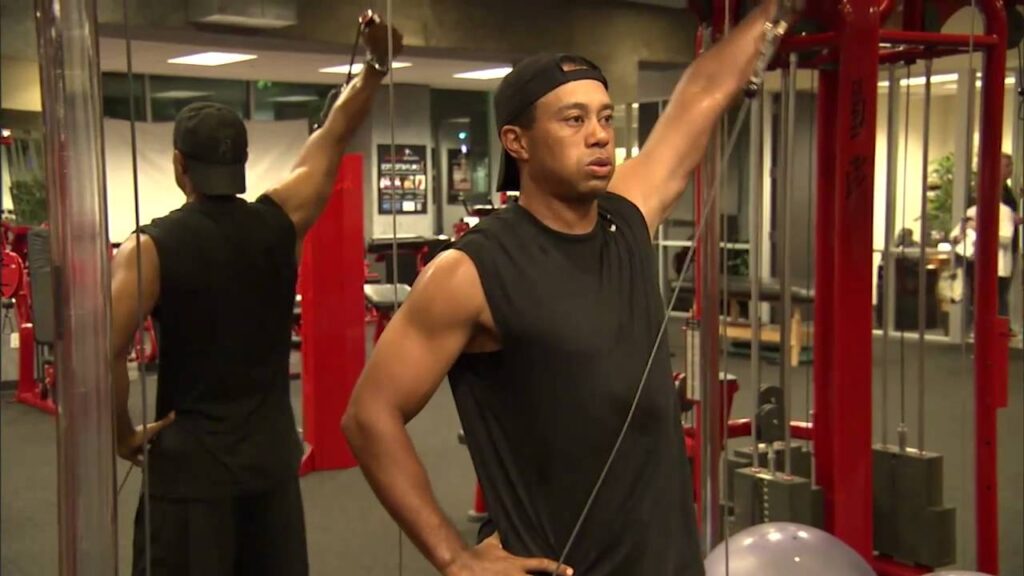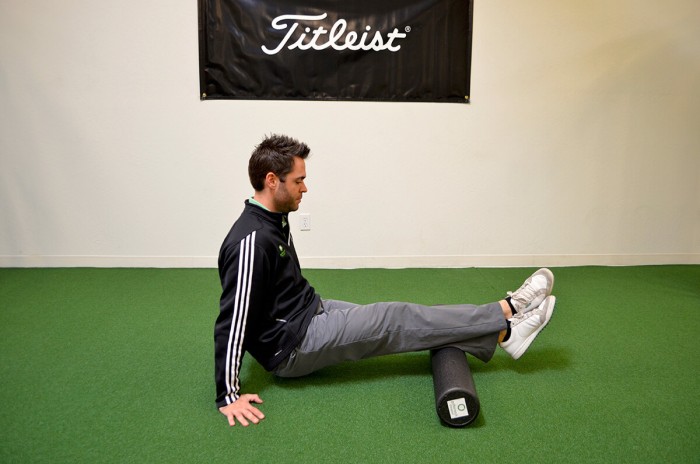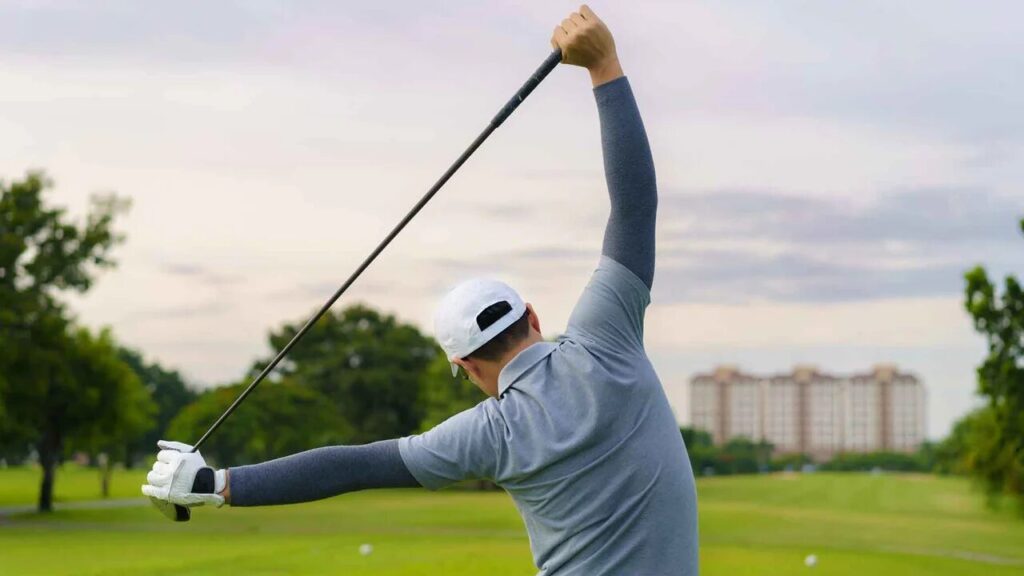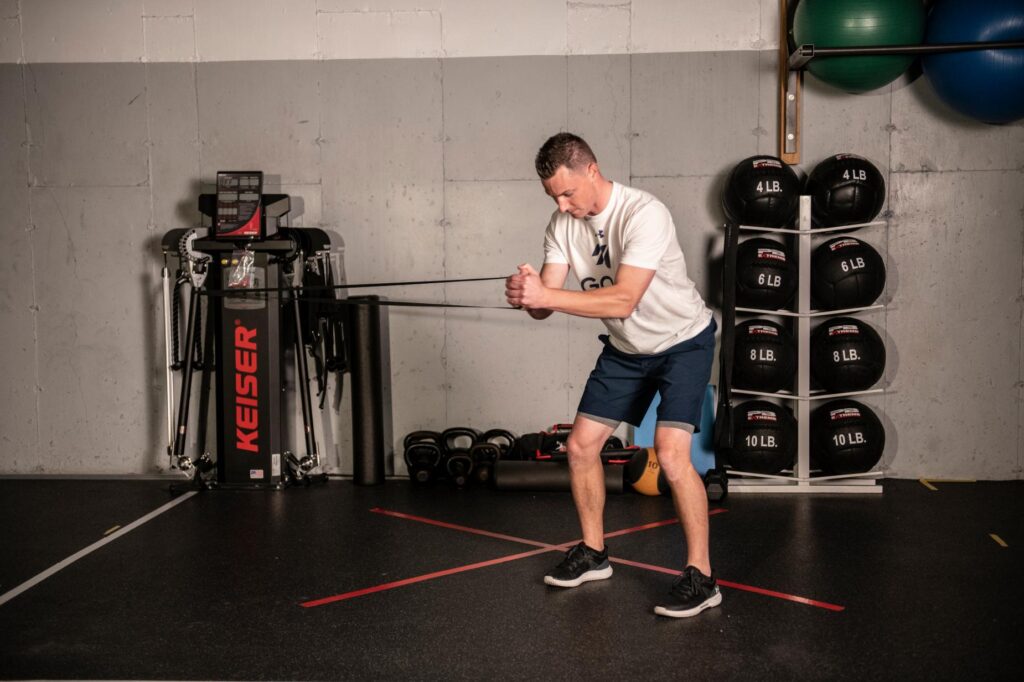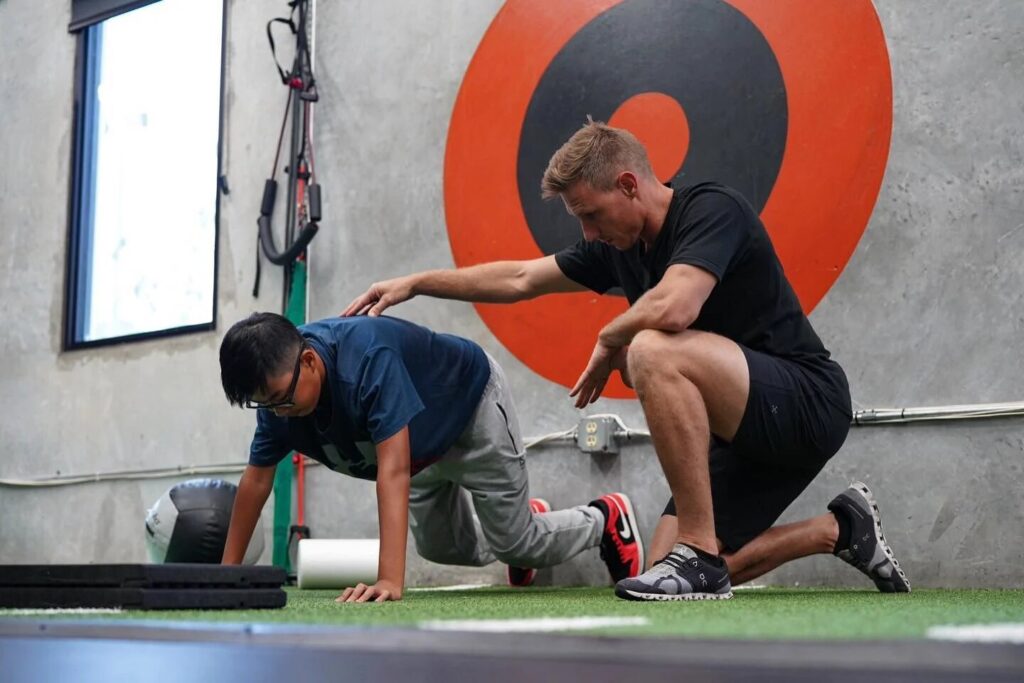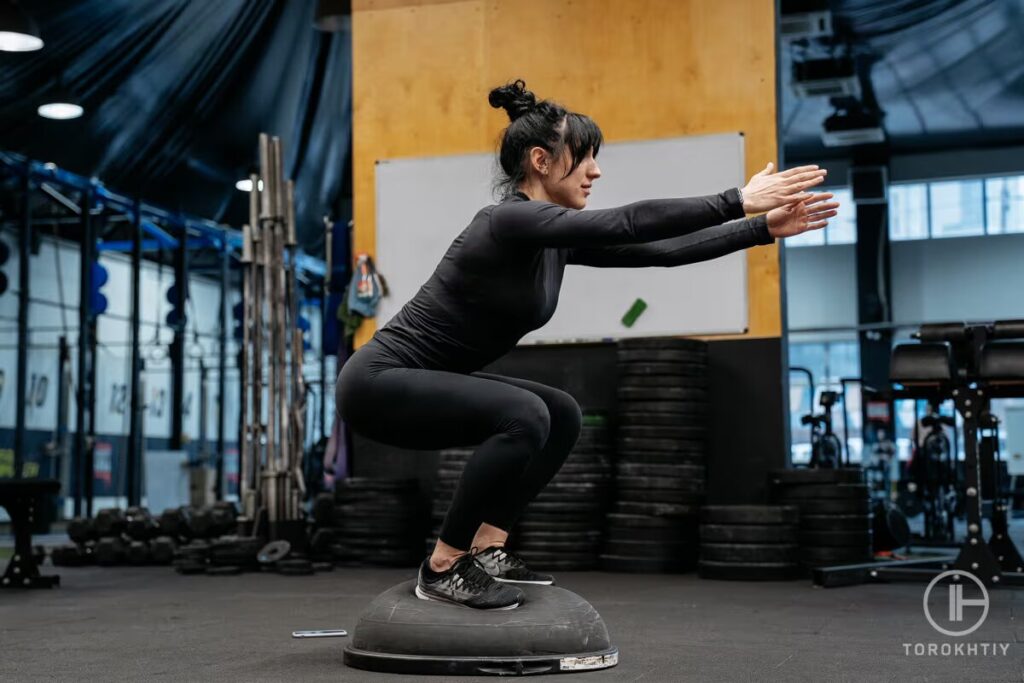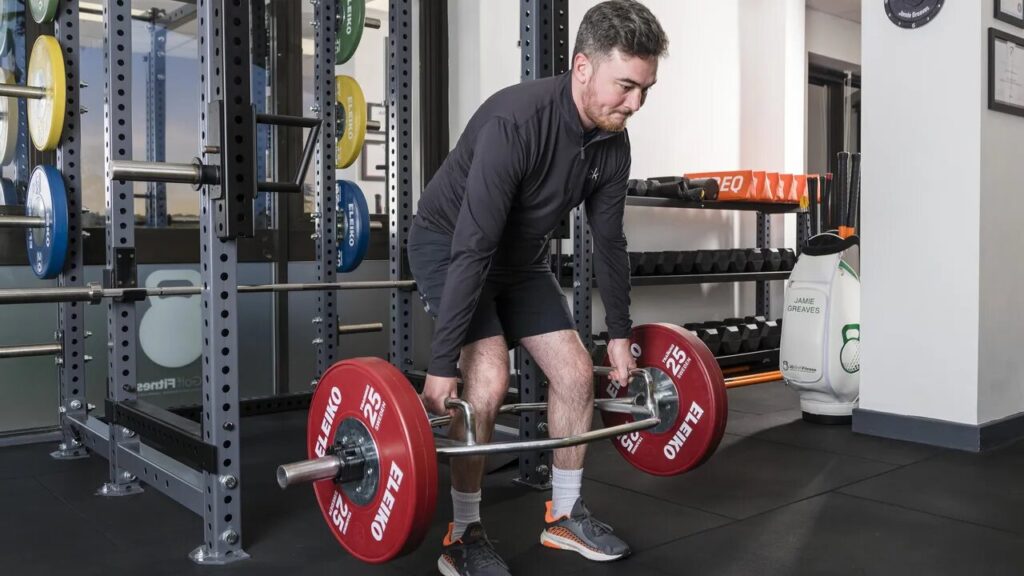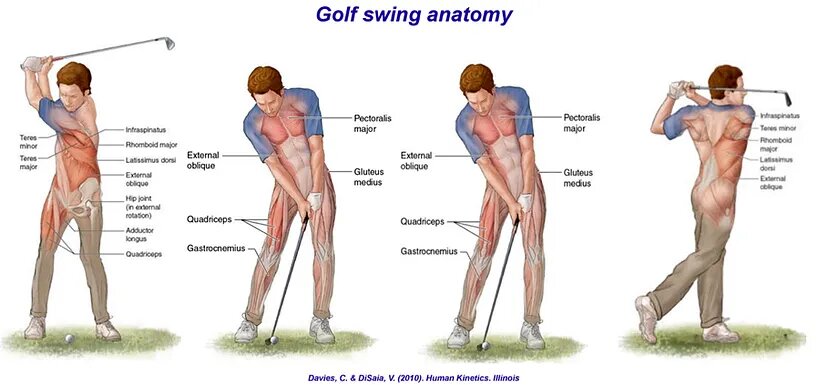Category Archives for Fitness and Training
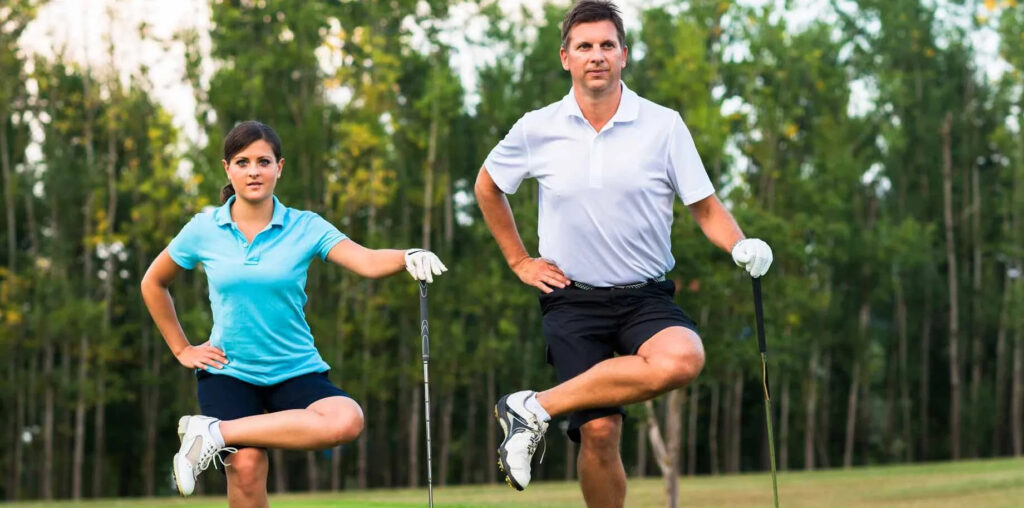
Cardiovascular Conditioning for Golf: Improving Endurance for 18 Holes
Looking to elevate your golf game? Enhancing your cardiovascular conditioning could be the answer.
We delve into the significance of cardiovascular conditioning for golf performance and its impact on excelling on the course.
From enhanced stamina to refined swing mechanics and heightened mental focus, endurance training offers various benefits for golfers.
We also cover strategies for integrating cardiovascular exercises into your golf training regimen and highlight common pitfalls to avoid.
Get set to enhance your endurance for a full round by incorporating these insights into your routine. Time to hit the course!
What is Cardiovascular Conditioning?
Cardiovascular conditioning refers to the process of enhancing the efficiency of the heart, lungs, and blood vessels through targeted exercises aimed at improving overall physical fitness and endurance.
This type of training plays a crucial role in maintaining a healthy heart and reducing the risk of cardiovascular diseases. Regular cardiovascular workouts help in lowering blood pressure, improving cholesterol levels, and enhancing circulation. In the realm of sports, a well-conditioned cardiovascular system leads to increased stamina, allowing athletes to perform at their peak for longer durations. It boosts aerobic capacity, enabling the body to efficiently utilize oxygen during physical activity, resulting in better endurance and overall improved performance.
How Does Cardiovascular Conditioning Affect Golf Performance?
Cardiovascular conditioning plays a crucial role in enhancing a golfer’s performance by improving endurance, increasing stamina, and supporting overall fitness levels.
This type of conditioning is essential for golfers to withstand the physical demands of playing 18-hole rounds, where they need to walk long distances, carry their clubs, and maintain focus and precision throughout each shot.
By building a strong cardiovascular foundation, golfers can ensure that they have the necessary energy reserves to perform consistently from the first tee to the final putt. Improving cardiovascular fitness also aids in recovery between rounds, allowing golfers to bounce back quickly and maintain their high level of play over multiple days of competition.
Why is Endurance Important for Golf?
Endurance is a critical factor in golf as it enables players to maintain high performance levels throughout an 18-hole game, sustain physical stamina, overcome golf challenges, and achieve peak performance.
When players have a high level of endurance, they are better equipped to handle the rigors of the game, whether it’s walking long distances, facing varying weather conditions, or enduring the mental strain of competition.
Endurance also plays a crucial role in sustaining energy levels, allowing golfers to maintain focus, precision, and consistency in their swings and overall gameplay.
By developing and enhancing their endurance, golfers can prolong their effectiveness on the course, leading to improved performance and greater enjoyment of the sport.
What are the Benefits of Cardiovascular Conditioning for Golf?
Cardiovascular conditioning offers numerous advantages for golfers, including increased stamina, improved swing mechanics, better mental focus, and a reduced risk of injury during play.
Engaging in regular cardiovascular training not only boosts overall endurance on the course but also plays a pivotal role in refining the intricacies of a golfer’s swing mechanics. The improved blood circulation from cardio workouts aids in enhancing muscle control and coordination, leading to more consistent and powerful swings. A strong cardiovascular system can significantly enhance mental focus and concentration during each shot, allowing golfers to maintain composure and make strategic decisions under pressure. By reducing the likelihood of fatigue and injury, proper cardiovascular conditioning contributes to prolonged sustainability in the game, enabling players to perform at their peak levels for extended periods.
Increased Stamina
Increased stamina resulting from cardiovascular conditioning leads to enhanced cardiovascular benefits, better overall health for golfers, improved peak performance, and optimized sports conditioning.
By engaging in specific golf fitness routines that focus on endurance and strength, golfers can witness significant improvements in their game. Not only does increased stamina help golfers maintain focus throughout a round, but it also helps them navigate challenging courses with ease. A well-conditioned cardiovascular system is crucial for preventing injuries and ensuring longevity in the sport. The overall well-being of golfers is enhanced when they commit to regular cardiovascular workouts, leading to increased energy levels, mental clarity, and reduced stress.”
Improved Swing Mechanics
Improved swing mechanics resulting from cardiovascular conditioning are characterized by enhanced golf swing movements, increased muscle endurance, elevated athlete’s endurance levels, and specialized golf fitness programs to overcome golf challenges.
These improved swing mechanics not only lead to smoother and more powerful swings but also contribute significantly to an athlete’s overall performance on the golf course. By focusing on muscle endurance, golfers can sustain their swings consistently throughout a round, thus minimizing fatigue and maintaining precision.
Tailored golf fitness programs play a crucial role in honing specific muscle groups essential for a successful swing, ensuring that the athlete’s body is primed for optimal performance. Strategies to maintain golf swing endurance include regular practice, proper warm-up routines, and efficient recovery techniques to prevent injuries and sustain peak performance levels.
Better Mental Focus
Better mental focus resulting from cardiovascular conditioning enables golfers to tackle golf challenges effectively, maintain consistent performance through structured golf fitness routines and daily exercises, leading to increased golfing success and optimal exercise intensity.
This heightened mental focus not only assists in honing technical skills on the golf course but also plays a vital role in enhancing decision-making abilities under pressure.
By sharpening their focus, golfers can overcome the mental hurdles that often arise during a round, helping them stay composed and make strategic choices.
A strong mental focus allows golfers to stay disciplined in adhering to their fitness regimens, ensuring they engage in the necessary exercises to improve their overall physical condition and endurance.
Reduced Risk of Injury
Reduced risk of injury due to cardiovascular conditioning enhances golfer’s participation in tournaments, shortens recovery time between play, strengthens essential golf muscle groups, emphasizes injury prevention, and mitigates potential golf-related injuries.
By incorporating injury prevention strategies into their training routines, golfers can proactively reduce the likelihood of common golf-related injuries such as golfer’s elbow, lower back strains, and shoulder injuries.
Targeted muscle group strengthening exercises, like core and shoulder stability workouts, not only improve performance on the course but also aid in preventing overuse injuries.
Quicker recovery periods allow golfers to maintain their peak physical condition, ensuring they stay competitive and ready for upcoming tournaments at all times.
How to Improve Endurance for Golf?
Improving endurance for golf involves a comprehensive approach that includes cardiovascular exercises, interval training, strength training, maintaining proper nutrition and hydration, and following a tailored exercise regimen to enhance a golfer’s overall performance.
Cardiovascular exercises play a crucial role in increasing a golfer’s stamina and overall wellness. By engaging in activities like running, swimming, or cycling, a golfer can improve heart health, lung capacity, and endurance on the golf course. Interval training is another effective method to boost endurance, alternating between bursts of high-intensity exercise and periods of rest.
Incorporating strength workouts, such as weightlifting or bodyweight exercises, enhances muscle strength necessary for powerful swings. A balanced diet rich in whole foods fuels the body for optimal performance, while proper hydration is key to preventing fatigue and maintaining focus during long rounds.
Tailoring exercise routines to mimic golf movements can target specific muscle groups and improve flexibility, resulting in enhanced endurance during gameplay.
Cardiovascular Exercises
Incorporating cardiovascular exercises into a golf fitness routine involves engaging in specific aerobic exercises and golf-focused workouts to enhance golfing skills, alleviate fatigue, strengthen golf muscles, and improve performance during practice sessions.
Aerobic workouts play a crucial role in enhancing a golfer’s cardiovascular endurance, which is vital for maintaining stamina and focus throughout a round of golf. By consistently incorporating cardio exercises into their training regimen, golfers can expect to see an improvement in their overall performance on the course.
These exercises not only help in reducing fatigue but also in building muscle strength, specifically targeting the muscles important for a powerful and precise golf swing. With increased exercise intensity, golfers can enhance their skills, reduce the risk of injury, and elevate their game to new heights.
Interval Training
Utilizing interval training techniques during the golfing season aids in achieving peak performance, enhancing golfing agility, following a structured workout plan for golfers, optimizing recovery time between sessions, and supporting overall physical stamina.
Interval training for golfers not only increases cardiovascular fitness but also helps in improving muscle strength and endurance. By incorporating high-intensity intervals, golfers can push their bodies to new limits, leading to better performance on the course. This type of training allows golfers to mimic the intensity of actual gameplay, preparing them for the physical demands of a round. The varying intensity levels in interval training sessions help in boosting metabolism and burning calories effectively, contributing to overall fitness and stamina improvement.
Strength Training
Implementing strength training regimens focuses on developing core strength, enhancing golf endurance, promoting golfer’s health, boosting performance levels, and incorporating golf-specific stretches for improved flexibility and strength.
Strengthening core muscles is crucial for golfers as it helps improve stability, balance, and power during swings. The endurance aspect of strength training aids in sustaining energy levels throughout a round of golf, enabling consistent performance from start to finish. The health benefits of strength training include reduced risk of injury and enhanced overall wellbeing.
By targeting specific muscle groups used in golf movements, such as the hips, shoulders, and core, golfers can witness significant improvements in their game, from increased distance off the tee to more precise shots on the green.
Proper Nutrition and Hydration
Maintaining proper nutrition and hydration supports a golfer’s exercise routine, fosters golfing success, sustains optimal fitness levels, addresses golfing challenges, promotes injury prevention, and enhances overall physical well-being.
When a golfer ensures they are consuming a well-rounded and balanced diet, they are providing their body with the necessary nutrients to fuel their performance on the golf course. Proper nutrition plays a crucial role in helping golfers navigate through the physical and mental demands of the game.
Hydration, on the other hand, is essential for maintaining focus and concentration during long rounds of golf, especially in challenging weather conditions. By paying attention to their nutritional intake and hydration levels, golfers can optimize their physical capabilities and set themselves up for success both on and off the golf course.
What is the Recommended Cardiovascular Conditioning for Golf?
The recommended cardiovascular conditioning for golf entails balancing the frequency, duration, and intensity of workouts to develop a golf-specific fitness program that enhances golf swing strength and fosters cardiovascular endurance for optimal on-course performance.
This tailored approach to golf fitness not only improves overall physical condition but also directly impacts one’s ability to generate power and maintain stamina throughout a round. By integrating strength training exercises that target core stability and rotational movements, golfers can enhance their swing mechanics and prevent injuries.
Combining cardio workouts like brisk walking, cycling, or swimming with strength building routines can significantly boost performance on the course. It’s essential to consult with a fitness professional to customize a program that suits individual needs and goals, ensuring a well-rounded and effective training regimen.
Frequency
Determining the optimal frequency of cardiovascular conditioning aligns with golf fitness goals, practice sessions, physical endurance requirements, adherence to a structured golf training plan, and the enhancement of golf swing speed for improved performance.
By establishing a consistent workout schedule that integrates cardiovascular exercises into your routine, you can effectively build up your endurance levels over time. This increased endurance not only helps you maintain focus and energy throughout your golf rounds but also contributes to better overall physical conditioning, which is crucial for achieving peak performance on the course. By aligning your workout frequency with your golf goals, you can fine-tune your training plan to target specific areas that need improvement, leading to enhanced efficiency during practice sessions and a more powerful and accurate golf swing.
Duration
Optimizing the duration of cardiovascular conditioning involves tailoring a golf fitness routine to enhance golf swing endurance, achieve golfing success, manage recovery time effectively, and strengthen essential golf muscle groups for improved performance.
By customizing workout duration to suit individual abilities and goals, golfers can experience gradual improvements in cardiovascular health and endurance. Implementing specific strategies such as interval training and circuit workouts can boost overall stamina on the golf course. Success in golf can be attained through consistent effort and dedication to fitness routines tailored to meet the demands of the sport.
Managing the post-workout recovery period efficiently is crucial for allowing the body to repair and grow stronger. Targeting key muscle groups with exercises like core strengthening and rotational movements can lead to enhanced performance and injury prevention.
Intensity
Balancing the intensity of cardiovascular conditioning focuses on enhancing golf swing strength, incorporating golf stamina drills, fostering cardiovascular endurance, improving golfing agility, and following a structured workout plan tailored to a golfer’s needs.
This approach to workout intensity plays a crucial role in helping golfers develop the power and control needed for effective swings on the course. By strategically incorporating strength training exercises that target key muscle groups involved in the golf swing, individuals can see significant improvements in their overall performance.
Including stamina drills specific to golfing movements can enhance a player’s ability to maintain focus and power throughout a round. Endurance training, such as long runs or interval sessions, contributes to building the cardiovascular capacity essential for enduring the demands of a full round of golf.
Agility drills not only improve a golfer’s coordination and balance but also help prevent injuries on the course. A personalized workout plan that considers a golfer’s skill level, physical condition, and goals is essential for maximizing the benefits of workout intensity in golf conditioning.
How to Incorporate Cardiovascular Conditioning into a Golf Training Program?
Incorporating cardiovascular conditioning into a golf training program involves seeking guidance from a golf fitness expert, tailoring workouts to address golf-specific needs, preventing golf-related injuries, enhancing golf swing speed, and integrating warm-up exercises for optimal performance.
- Experts recommend incorporating exercises such as running, cycling, or rowing to improve cardiovascular endurance crucial for maintaining energy levels throughout a round.
- Customizing workouts to focus on core strength and rotational power can significantly enhance a golfer’s performance on the course.
- Injury prevention measures like proper warm-up routines and stretching exercises before and after training sessions help in reducing the risk of common golf ailments such as golfer’s elbow or lower back pain.
- Speed enhancement strategies, including plyometric drills and interval training, can also contribute to improving swing speed and overall golf skill development.
What are the Common Mistakes in Cardiovascular Conditioning for Golf?
Common mistakes in cardiovascular conditioning for golf include neglecting specific golfing muscles, overlooking flexibility training, inadequate focus on essential muscle groups, and skipping essential cool-down routines post-workout.
When it comes to cardiovascular conditioning in golf, one of the common errors observed is the neglect of muscles that are specifically crucial for golf swings and movements. This can lead to an imbalance and inefficiency in the golf swing, affecting both performance and risking injury.
Flexibility training is often underestimated, yet it plays a vital role in improving range of motion and preventing muscle strain during the golf swing. In addition, not focusing enough on essential muscle groups such as the core, glutes, and shoulders can hinder power generation and stability in the golf swing.
Skipping the cool-down routine after a workout deprives the muscles of the opportunity to gradually relax and recover, potentially leading to muscle stiffness and decreased performance in subsequent practice sessions or games.
How to Avoid Injury while Performing Cardiovascular Conditioning for Golf?
Preventing injuries during cardiovascular conditioning for golf involves focusing on correct golf swing mechanics, implementing injury prevention strategies, strengthening essential golf muscles, maintaining flexibility, allowing adequate recovery time, and striving for injury-free golf performances.
- One key aspect of injury avoidance in golf is understanding the crucial role that proper swing mechanics play in reducing strain on the body. By ensuring that your swing is fluid and consistent, you can minimize the risk of overuse injuries.
- Incorporating specific muscle-strengthening exercises tailored to golf movements can help build resilience in the body. Flexibility maintenance through regular stretching routines is essential for preventing muscle imbalances that can lead to injuries during play.
- Managing recovery durations between sessions is equally important to give your body time to rest and repair, ultimately contributing to longevity and sustained performance on the golf course.

Mental Conditioning for Golfers: Strengthening the Mind-Body Connection
Are you looking to take your golf game to the next level?
Mental conditioning could be the key to unlocking your full potential on the course.
We explore what mental conditioning for golfers is and how it differs from physical conditioning.
Discover why mental conditioning is crucial for improving performance and learn about visualization techniques and positive self-talk.
We discuss how golfers can incorporate mental conditioning into their training and address common challenges they may face.
Learn how to maintain mental conditioning in the long term and elevate your game.
What is Mental Conditioning for Golfers?
Mental conditioning for golfers involves the psychological techniques and practices aimed at enhancing golfing performance through the mind-body connection. It focuses on strengthening the mental aspects of the game to improve focus, visualization, confidence, and relaxation during play.
By honing mental skills, golfers can visualize their shots, building a mental blueprint of each swing in advance. This visualization not only boosts confidence but also helps in executing shots with precision.
By fostering a state of relaxation, golfers can maintain composure under pressure and make more consistent swings. The mind-body connection plays a crucial role in golf performance, allowing players to stay grounded, focused, and in tune with the nuances of the game.
How Does Mental Conditioning Differ from Physical Conditioning?
Mental conditioning for golfers differs from physical conditioning in that mental conditioning focuses on improving the psychological skills, mindset, and resilience of golfers, whereas physical conditioning mainly targets the body’s strength, flexibility, and endurance through specific training regimens.
By honing the mental aspect, golfers can develop focus, concentration, visualization, and coping strategies for pressure situations on the course. Working on their psychology enables athletes to manage emotions, handle setbacks, and maintain confidence during rounds.
On the other hand, physical conditioning involves exercises to enhance golf-specific movements, build core stability, increase power, and prevent injuries common in the sport. Training programs often include strength training, cardiovascular workouts, flexibility drills, and mobility exercises to optimize an athlete’s performance.
Why is Mental Conditioning Important for Golfers?
Mental conditioning is vital for golfers as it plays a crucial role in enhancing performance, concentration, and mindfulness on the course. It enables golfers to develop a resilient mindset, manage pressure, and excel in competitive environments.
Through mental conditioning, golfers can improve their game by focusing on building mental toughness, visualizing success, and staying composed under pressure. By honing their mental skills, golfers can navigate the challenges of the game with more ease and clarity, leading to better decision-making and performance consistency.
A strong mental game not only bolsters confidence but also fosters a growth mindset, allowing golfers to learn from setbacks and adapt their strategies for future success.
How Does Mental Conditioning Improve Performance?
Mental conditioning enhances the performance of golfers by shaping a positive mindset, boosting self-belief, and fostering greater control over emotions and actions on the course. It empowers athletes to cultivate mental toughness and visualization techniques for peak performance.
Such mental preparation plays a crucial role in determining success on the golf course. By instilling a deep sense of motivation and self-belief, golfers can overcome challenges and setbacks with resilience and determination.
This unwavering mental strength enables players to stay focused under pressure, make strategic decisions, and execute shots with precision. The ability to maintain emotional control in high-pressure situations is key to achieving consistent performance and pushing the boundaries of one’s capabilities.
Ultimately, a well-conditioned mind is a golfer’s best asset in attaining success and reaching optimal performance levels.
What are the Key Elements of Mental Conditioning for Golfers?
The key elements of mental conditioning for golfers encompass visualization techniques, positive self-talk, goal setting, and relaxation methods. These techniques aim to enhance focus, confidence, and mental resilience for optimal golfing performance.
Visualization techniques play a crucial role in mental conditioning for golfers as they involve creating vivid mental images of successful shots and scenarios, helping players build muscle memory and improve their overall game.
Positive self-talk is another vital aspect that involves cultivating a mindset of self-belief and encouragement, fostering a constructive inner dialogue that boosts confidence and drives motivation.
Relaxation methods such as deep breathing exercises and mindfulness practices can help golfers manage stress, stay composed, and maintain a calm state of mind on the course.
Visualization Techniques
Visualization techniques involve the practice of mentally picturing successful golf shots, scenarios, and outcomes to enhance performance. By incorporating elements of meditation, mental imagery, and positive visualization, golfers can mentally prepare for their game.
Through visualization exercises, golfers can create a mental blueprint of the perfect swing, ideal ball trajectory, and successful putts before even stepping on the course. This process helps in boosting confidence, reducing anxiety, and developing focus.
By consistently visualizing their desired outcome, players can train their mind to react instinctively during high-pressure situations, leading to improved decision-making and overall performance on the golf course. Engaging in visualization aids in developing muscle memory, reinforcing proper techniques, and maintaining a positive mindset throughout the game.
Positive Self-Talk
Positive self-talk involves the use of encouraging and empowering affirmations to build confidence, self-belief, and mental toughness in golfers. By maintaining a positive inner dialogue, players can overcome challenges and stay focused during their rounds.
This practice not only impacts a golfer’s mental state but also has a direct influence on their performance on the course. Confidence is key in golf, as it helps players trust their skills and make decisive shots under pressure. By reinforcing positive thoughts such as ‘I have control over my game‘ or ‘I believe in my abilities,’ golfers can enhance their self-belief and improve overall performance. It’s about training the mind to support and uplift the player, creating a strong foundation for success in the game.
Goal Setting
Goal setting is a fundamental aspect of mental conditioning for golfers, promoting self-awareness, positive thinking, and continuous improvement. Setting specific, achievable goals helps players stay motivated, focused, and committed to their development.
Through goal setting, golfers can gain a deeper understanding of their strengths and weaknesses, allowing them to tailor their practice sessions effectively. By setting incremental goals that are challenging yet attainable, players cultivate a growth mindset that fuels their progress on the course. Clear goals provide a sense of direction and purpose, instilling confidence and resilience in the face of obstacles.
To enhance goal achievement, it is essential to regularly review and adjust goals, celebrate milestones, and maintain a positive attitude towards setbacks as opportunities for learning and improvement.
Relaxation Techniques
Relaxation techniques are essential for golfers to manage stress, enhance relaxation, and regulate their emotions on the course. By practicing relaxation methods, athletes can cultivate mental composure, reduce anxiety, and optimize performance under pressure.
- One effective relaxation technique for golfers is deep breathing exercises, which help calm the mind and body. Taking slow, deep breaths can lower heart rate and increase oxygen flow, promoting a sense of calmness and focus.
- Visualization is another powerful method, where golfers mentally rehearse successful shots or scenarios, boosting confidence and reinforcing positive outcomes.
- Progressive muscle relaxation involves tensing and relaxing muscle groups systematically to release tension and improve body awareness. These techniques, when incorporated into training routines, can enhance stress reduction, emotional resilience, and cognitive skills for golfers.
How Can Golfers Incorporate Mental Conditioning into their Training?
Golfers can effectively integrate mental conditioning into their training by practicing visualization on the course, using positive affirmations during practice sessions, setting specific goals, and incorporating mindfulness and breathing exercises. These techniques contribute to enhancing mental focus, self-belief, and overall performance.
By incorporating visualization practices into their routine, golfers can mentally rehearse their shots, visualize successful outcomes, and reinforce a positive mindset. Positive affirmations help in building confidence and promoting a winning mentality during practice. Setting specific goals provides a sense of direction and purpose, which is essential for motivation and progress in mental conditioning. Mindfulness training allows golfers to stay present, manage distractions, and develop a strong mental resilience on the course.
Practice Visualization on the Course
Practicing visualization on the course involves mentally rehearsing shots, strategies, and scenarios to enhance golfing skills and mental preparation.
This technique not only helps in improving performance on the course but also contributes significantly to mental health and overall well-being. By engaging in visualization exercises, golfers can effectively manage stress, anxiety, and distractions on the course, allowing them to focus better on their game.
Visualization plays a vital role in developing a strong mindset for peak performance by training the brain to stay calm and focused under pressure. Some effective visualization exercises include visualizing the perfect swing, a flawless putt, or successfully navigating a challenging hole.
Use Positive Affirmations during Practice Sessions
Using positive affirmations during practice sessions helps golfers boost self-confidence, develop coping strategies, and maintain a positive mindset. By incorporating affirmations that inspire belief and resilience, players can overcome challenges and setbacks effectively.
These affirmations serve as powerful tools in enhancing mental strength and emotional control on the golf course. Affirmations focused on self-confidence can help golfers make decisive decisions under pressure, reinforcing their belief in their abilities.
For example, repeating statements like ‘I trust my skills and stay calm under any circumstances‘ can instill a sense of mental clarity during crucial shots. Similarly, affirmations such as ‘I embrace challenges and grow stronger with each obstacle‘ can foster a resilient mindset that propels players forward in the face of adversity.
Set Specific, Achievable Goals
Setting specific and achievable goals is crucial for golfers to foster mindful movement, enhance emotional resilience, and stay motivated on their improvement journey. By establishing clear objectives, players can channel their focus and efforts towards continuous growth and success.
Setting goals not only helps golfers improve their performance on the course but also strengthens their mental strategies off the greens. It encourages players to break down their overall objectives into manageable steps, making progress feel more attainable. This sense of accomplishment boosts confidence and reinforces the belief in one’s abilities. Creating goals tailored to personal strengths and areas for improvement instills a sense of purpose and direction in a golfer’s practice routine, aligning intentions with actions for sustainable progress.
Incorporate Mindfulness and Breathing Exercises
Incorporating mindfulness and breathing exercises is beneficial for golfers to manage stress effectively, promote relaxation, and cultivate mindful awareness during play. By practicing mindful breathing techniques, athletes can enhance their focus, reduce tension, and optimize their performance on the course.
These stress reduction techniques not only have physical benefits but also contribute to mental focus and emotional control on the golf course. Engaging in mindfulness practices, such as deep breathing and visualization, can help golfers stay present, make better decisions, and maintain composure under pressure. Through regular integration of breathwork and visualization practices into their routine, players can develop a deeper connection between mind and body, leading to improved concentration, heightened self-awareness, and ultimately, better overall performance.
What are Some Common Challenges in Mental Conditioning for Golfers?
Golfers often face common challenges in mental conditioning, such as overcoming negative self-talk, managing pressure and nerves on the course, and staying focused and present during rounds. These obstacles can impact performance and require specific strategies to navigate effectively.
One vital aspect of mental conditioning for golfers is developing a strong mindset that supports success and motivation on the course. Positive affirmations and visualization techniques can help reframe negative self-talk into constructive thoughts, reinforcing belief in one’s abilities. Implementing pre-shot routines and mindfulness practices can aid in managing pressure and improving focus by channeling energy towards the present moment. By addressing these challenges head-on and consistently working on mental resilience, golfers can enhance their performance and overall enjoyment of the game.
Overcoming Negative Self-Talk
Overcoming negative self-talk in golf involves recognizing and reframing internal dialogues that hinder performance, self-belief, and mental toughness. By implementing stress management techniques and fostering a positive mindset, golfers can mitigate self-doubt and enhance their mental resilience.
One effective strategy for golfers to address negative self-talk is through visualization exercises. By vividly imagining successful shots and positive outcomes, players can cultivate a sense of confidence and belief in their abilities. Practicing mindfulness and meditation can help golfers stay present, calm their minds, and improve focus during critical moments on the course. These techniques not only aid in managing stress but also contribute to developing mental toughness and resilience in challenging situations, ultimately leading to improved performance.
Dealing with Pressure and Nerves on the Course
Managing pressure and nerves on the course is crucial for golfers to optimize performance, maintain emotional control, and make effective decisions under stress. By employing stress relief techniques and enhancing decision-making skills, players can navigate challenging situations with composure and confidence.
One effective strategy for managing pressure in golf is incorporating relaxation exercises into your routine. Engaging in deep breathing exercises or visualization techniques can help calm the mind and body, allowing for better focus and clarity during critical moments on the course. Utilizing performance psychology principles, such as positive self-talk and goal-setting, can contribute to mental balance and resilience against high-pressure situations. Taking time to practice emotional regulation techniques off the course can prepare you for staying composed during competitive rounds and improve your overall performance.
Staying Focused and Present during a Round
Maintaining focus and presence during a round is essential for golfers to sustain concentration, engage in mindful living practices, and embody an athletic mindset on the course. By incorporating concentration exercises and mindfulness techniques, players can enhance their performance and stay grounded in the present moment.
This ability to stay focused not only impacts their shot-making abilities but also contributes to their emotional well-being and mental strength. Golf coaching often emphasizes the significance of cultivating an athletic mindset, which involves resilience, adaptability, and strategic thinking on the course.
Through guided visualizations, deep breathing exercises, and maintaining a positive attitude, golfers can navigate challenges with ease and perform at their peak. Practicing mindfulness off the course, such as meditation and goal setting, helps players develop a holistic approach to their game and overall well-being.
How Can Golfers Maintain Mental Conditioning in the Long Term?
Golfers can sustain mental conditioning in the long term by engaging in regular practice and reinforcement of techniques, seeking professional help and guidance when needed, and incorporating mental conditioning into their daily life for continuous improvement. These strategies promote mental fitness and resilience over the course of their golfing journey.
Consistent mental focus is crucial when it comes to enhancing performance on the golf course. Mindfulness techniques, such as deep breathing and visualization, can aid in sharpening focus and maintaining a calm, clear mindset during rounds.
Considering performance coaching to fine-tune mental skills can provide valuable insights and tailored strategies for achieving peak mental performance. Integrating short mental conditioning exercises into daily routines, like setting intentions before each practice session or competition, reinforces mental strength and aids in building a strong foundation for long-term success.
Regular Practice and Reinforcement of Techniques
Regular practice and reinforcement of mental techniques are essential for golfers to refine their mental skills, enhance sports performance, and promote overall wellness. By dedicating time to mental conditioning exercises, athletes can build resilience, improve focus, and achieve peak performance on the course.
Consistent mental conditioning can aid in stress management, decision-making under pressure, and maintaining emotional stability during competitions. Engaging in activities such as visualization, mindfulness, and goal-setting can help athletes stay grounded and mentally sharp. Sports psychology techniques, such as positive self-talk and confidence-building exercises, play a crucial role in boosting mental health and performance. It is important to incorporate these practices into a regular training routine to nurture a strong mind-body connection and cultivate a winning mindset.
Seeking Professional Help and Guidance
Golfers can benefit from seeking professional help and guidance to develop their golf mindset, enhance emotional intelligence, and learn effective stress relief techniques. By consulting with sports psychologists or coaches, players can gain valuable insights and personalized strategies to overcome mental challenges and excel in their game.
Understanding the significance of emotional control and self-motivation in golf is crucial for optimizing performance on the course. Professional assistance can offer specialized techniques for managing emotions under pressure and staying focused during critical moments.
In addition to honing mental skills, mind-body techniques like visualization and breathing exercises can be taught to promote relaxation and improve concentration levels when facing tough shots. Investing in mental conditioning not only refines one’s game but also fosters a positive mindset that contributes to overall well-being both on and off the golf course.”
Incorporating Mental Conditioning into Daily Life
Incorporating mental conditioning into daily life is essential for golfers to enhance cognitive performance, refine golf strategies, and foster athletic development beyond the course. By integrating mental conditioning practices into daily routines, players can cultivate a resilient mindset and sustain high-level performance both on and off the fairways.
This mental conditioning not only sharpens decision-making skills on the golf course but also promotes overall mental clarity, enabling golfers to stay focused and composed under pressure.
Incorporating elements of golf fitness training alongside mental conditioning can lead to a more holistic approach to athletic development, improving physical endurance and mental resilience.
Consistency in mental conditioning routines can have a significant impact on refining golf strategies, aiding in strategic planning and execution during tournaments and practice sessions.
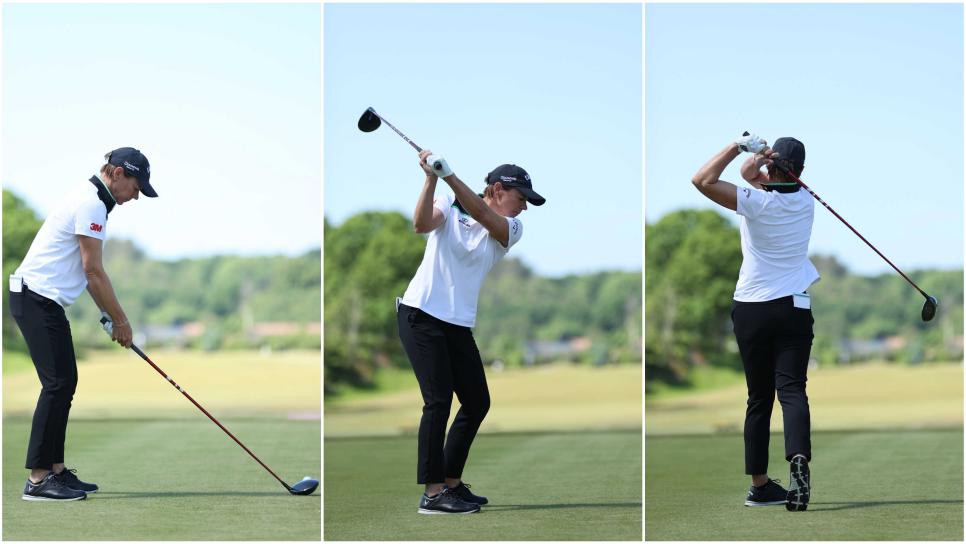
Injury Prevention Strategies for Golfers: Keeping Swings Smooth and Bodies Strong
Golf is a sport loved by millions around the world, but it can also come with its fair share of injuries.
From back strains to wrist sprains, golfers are prone to a variety of physical setbacks that can hinder their game.
We will explore the most common golf injuries and their causes, as well as provide valuable tips on how to prevent them.
Whether you’re a seasoned pro or a beginner on the green, these injury prevention strategies will help keep your swings smooth and your body strong.
Common Golf Injuries and Their Causes
Golfers are prone to various injuries due to the repetitive nature of their swings and the demands it places on their bodies. Common golf injuries include shoulder injuries, elbow injuries, wrist injuries, back injuries, hip injuries, knee injuries, and ankle injuries. These injuries can range from rotator cuff strains, flexor tendinitis, golfer’s elbow, to lower back pain.
Shoulder injuries are often caused by the overhead movements involved in golf swings, leading to issues like impingement syndrome and rotator cuff tears. Symptoms may include pain, weakness, and limited range of motion. To prevent shoulder injuries, golfers should focus on proper warm-ups, strengthening exercises, and maintaining good swing mechanics.
Similarly, elbow injuries, such as tennis elbow and golfer’s elbow, are common among golfers due to overuse. To avoid these, it’s important to practice correct grip and swing techniques and incorporate rest and stretching into a regular routine.
Back Injuries
Back injuries are common among golfers, often attributed to poor swing mechanics, lack of core stability, and inadequate muscle strength. Lower back pain is a prevalent issue that can hinder a golfer’s performance and lead to long-term problems if not addressed.
To prevent back injuries in golfers, it is crucial to focus on improving core stability through targeted exercises. Strengthening the core muscles, such as the abdominals, obliques, and lower back muscles, can help provide better support for the spine during the repetitive motions of the golf swing. Incorporating flexibility exercises to maintain proper range of motion in the hips and spine is essential for injury prevention. Rehabilitation strategies for golfers with back injuries often involve a combination of targeted exercises, manual therapy, and postural adjustments to address muscle imbalances and alignment issues.
Shoulder Injuries
Shoulder injuries are a common concern for golfers due to the repetitive nature of the golf swing. Understanding the biomechanics of the shoulder, proper muscle activation, and maintaining a full range of motion are crucial for injury prevention and optimizing golf performance.
In golf, common shoulder injuries include rotator cuff strains, shoulder impingement, and labral tears, which can result from overuse or poor swing mechanics.
Biomechanical factors such as shoulder blade positioning, scapular stability, and thoracic spine mobility play a significant role in shoulder health. Utilizing muscle activation techniques like scapular retraction and depression can help stabilize the shoulder joint during the golf swing.
Incorporating range of motion exercises like shoulder external rotations and overhead stretches can enhance flexibility and prevent tightness in the shoulder muscles. Shoulder stability is essential for maintaining proper golf swing mechanics and generating power and accuracy in shots.
Elbow Injuries
Elbow injuries, such as golfer’s elbow, are prevalent in golfers and can result from poor swing technique, lack of flexibility, and improper muscle activation. Preventing elbow injuries requires proper biomechanics, flexibility training, and targeted muscle activation.
Including exercises that strengthen the forearm muscles and improve grip strength can help in preventing elbow injuries.
Techniques like using proper equipment and ensuring the golf clubs are custom-fitted to the player’s build can also reduce strain on the elbows.
Maintaining correct posture throughout the swing and avoiding excessive force can significantly lower the risk of golfer’s elbow.
Focusing on a smooth and controlled swing motion rather than overexerting oneself can protect the elbows from unnecessary stress.
Incorporating regular stretching routines to enhance flexibility and mobility in the elbows further contributes to injury prevention.
Wrist Injuries
Wrist injuries, including golfer’s wrist, can occur due to improper swing mechanics, lack of flexibility, and limited range of motion. Preventing wrist injuries involves enhancing flexibility, perfecting swing technique, and ensuring adequate muscle activation to support the wrist joint.
Flexibility plays a crucial role in maintaining wrist health among golfers as it allows for a smoother swing execution and reduces the strain placed on the wrist joint. By incorporating dynamic stretching routines into their pre-game warm-ups, golfers can improve their flexibility and minimize the risk of developing common wrist injuries.
Focusing on muscle activation through targeted exercises, such as wrist curls and forearm strengthening movements, can enhance wrist stability and prevent overuse injuries. Maintaining a proper range of motion through regular stretching and mobility drills is essential for promoting overall wrist health and longevity in golfers.
Knee Injuries
Knee injuries are a significant concern for golfers, often arising from imbalances, lack of core stability, and inadequate conditioning. Implementing balance training, core stability exercises, and a proper conditioning regimen are essential for preventing knee injuries and maintaining optimal performance on the golf course.
When it comes to knee injuries in golfers, some of the common issues include meniscus tears, patellar tendinitis, and ligament strains. These injuries can be exacerbated by the repetitive nature of the golf swing and the stress it places on the knees.
In order to prevent these injuries, golfers should focus on exercises that improve flexibility, strength, and stability in the knee joint. Rehabilitation approaches often involve physical therapy to strengthen the muscles around the knee and improve range of motion. Core strength plays a crucial role in reducing the risk of knee injuries by providing stability and support during the golf swing.
How to Prevent Golf Injuries?
Preventing golf injuries involves a comprehensive approach that includes warm-up routines, specific stretching exercises, focusing on proper swing technique, enhancing strength and conditioning, and effective injury management. Implementing a tailored fitness routine and preventive care can significantly reduce the risk of injuries and improve overall wellness.
Engaging in proper warm-up activities before a round of golf is essential to prepare the body for the physical demands of the sport. Dynamic stretches such as leg swings, arm circles, and trunk rotations can help improve flexibility and range of motion, crucial for a smooth and powerful golf swing. Golfers can also benefit from incorporating strength training exercises targeting core muscles, shoulders, and legs to enhance stability and power generation, leading to more consistent performance on the course.
Following injury management protocols, such as icing sore muscles and seeking professional guidance when needed, is key to recovering effectively and preventing further setbacks in your golf game. By developing a preventive care plan that includes regular stretching, strength training, and proper technique practices, golfers can enjoy the game while minimizing the risk of common golf-related injuries.
Warm-Up and Stretching
Warm-up and stretching are vital components of injury prevention for golfers. Engaging in dynamic warm-up exercises to prepare the body for movement and incorporating specific stretches to enhance flexibility can help reduce the risk of injuries during golf play.
Prior to teeing off, golfers should focus on movements that mimic the actions involved in a golf swing, such as arm circles, leg swings, and torso rotations. These dynamic exercises help increase blood flow to the muscles and joints, priming them for the physical demands of the game.
Targeted stretches for the hamstrings, hip flexors, shoulders, and spine are also crucial for improving range of motion and preventing strains or tears. A well-rounded conditioning program that includes strength training and cardiovascular exercise can further support golfers in staying injury-free on the course.
Proper Technique and Form
Mastering proper technique and form is essential for injury prevention in golf. Understanding the biomechanics of the golf swing, optimizing golf swing mechanics, and focusing on muscle activation can help golfers maintain a consistent and injury-free performance.
By mastering the correct posture and alignment in each swing, golfers can reduce the stress on their muscles and joints. The sequencing of movements during the swing, such as the rotation of the hips and shoulders, plays a crucial role in generating power and accuracy. Having a strong core and stable lower body is vital for transferring energy efficiently through the swing. Engaging specific muscle groups, like the core muscles, glutes, and forearm muscles, helps in creating a more powerful and controlled swing, thus reducing the risk of overuse injuries. Consequently, integrating proper technique and biomechanical principles into one’s practice routine is key to enhancing performance and longevity in golf.
Strengthening Exercises
Incorporating strengthening exercises into a golf fitness routine is crucial for injury prevention and performance enhancement. Building core stability, increasing overall strength, and focusing on muscle strength can contribute to injury-free golfing and improved athletic abilities.
Activities like planks, Russian twists, and medicine ball throws can help golfers strengthen their core muscles, which are vital for generating power in their swings.
Squats, lunges, and deadlifts are excellent for enhancing overall strength and stability.
Utilizing resistance bands and bodyweight exercises can target specific muscles used in the golf swing, such as the shoulders, back, and hips.
By consistently incorporating these exercises into their workout regimen, golfers can improve their swing mechanics, prevent injuries, and optimize their performance on the course.
Rest and Recovery
Rest and recovery play a crucial role in injury prevention and overall health maintenance for golfers. Adequate rest periods, proper recovery strategies, and injury management protocols are essential for sustaining long-term wellness and injury-free golfing.
Ensuring sufficient rest allows the body to repair and strengthen itself after physical exertion, reducing the risk of overuse injuries common in golf. Effective recovery strategies involve hydration, nutrition, and sleep to support muscle recovery and energy restoration. Injury management through proper diagnosis, treatment, and rehabilitation is fundamental in ensuring a golfer’s swift return to the course after an injury. Regular health maintenance practices such as stretching, strength training, and regular check-ups contribute to overall fitness and injury resilience in golfers.
Other Strategies for Injury Prevention
In addition to warm-up routines and strength training, other strategies can enhance injury prevention for golfers. Ensuring the use of proper equipment and gear, maintaining adequate nutrition and hydration, and adapting to different playing conditions are vital components of a holistic approach to injury prevention.
Appropriate equipment plays a crucial role in preventing injuries on the golf course. Using well-fitted clubs, comfortable shoes, and protective gear not only improves performance but also reduces the risk of strains and sprains.
Nutrition and hydration are equally essential, as they support muscle function and overall well-being. Staying hydrated and consuming balanced meals can help golfers maintain energy levels and focus during games.
Adapting to diverse playing conditions, such as varying terrains and weather, enhances flexibility and resilience in the face of challenges.
Proper Equipment and Gear
Selecting and using proper golf equipment and gear is critical for injury prevention and optimal performance. Golf fitness equipment tailored to individual needs and regular golf injury assessments can help golfers identify potential risks and mitigate them proactively.
When it comes to golf fitness gear, investing in items like resistance bands, foam rollers, and stability balls can significantly contribute to enhancing strength, flexibility, and mobility crucial for preventing injuries.
Regular golf injury assessments conducted by professionals such as physical therapists or sports medicine experts can pinpoint any weaknesses or imbalances in a golfer’s body, allowing for targeted exercises and adjustments to reduce the likelihood of injury.
By optimizing equipment choices, such as selecting clubs with appropriate shaft flex and grip size, golfers can minimize strain on their joints and muscles, thus lowering the risks of common golf-related injuries.
Adequate Nutrition and Hydration
Maintaining proper nutrition and hydration levels is essential for golfers to support their performance and prevent injuries. Engaging in golf health education programs can enhance awareness of dietary requirements and hydration strategies for optimal health maintenance.
A balanced diet rich in carbohydrates, lean proteins, and healthy fats can provide the energy needed for a full round of golf while supporting muscle recovery and endurance. Incorporating fruits, vegetables, and whole grains into meals and snacks can boost vitamin and mineral intake, aiding in overall health and well-being.
Hydration plays a crucial role in regulating body temperature and preventing muscle cramps, emphasizing the importance of drinking water before, during, and after a game. By prioritizing nutrition and hydration, golfers can optimize their performance on the course and reduce the risk of injuries.
Adjusting to Different Playing Conditions
Adapting to diverse playing conditions is crucial for injury prevention and performance consistency in golf. Incorporating golf conditioning exercises, focusing on physical fitness, and leveraging sports science principles can help golfers optimize their abilities across varying playing environments.
Different playing conditions in golf, such as varying weather, terrain, and course layouts, demand flexibility and adaptability from players. By engaging in targeted golf conditioning exercises like core strengthening, flexibility drills, and balance training, golfers can enhance their performance and reduce the risk of injuries.
This strategic approach not only improves physical fitness but also sharpens mental focus, decision-making skills, and overall game management. Sports science plays a vital role in providing evidence-based strategies for golfers to reach their peak performance potential and elevate their game to new heights.
Injury Prevention for Senior Golfers
Senior golfers require specialized injury prevention strategies tailored to age-related changes and physical limitations. Regular check-ups, attentive listening to the body’s signals, and prioritizing golfer’s health are essential aspects of maintaining longevity and well-being in senior golfers.
As individuals age, various physiological changes may impact their golf performance and overall physical capabilities. It is crucial for senior golfers to undergo regular health assessments to address any emerging issues promptly.
By staying proactive and vigilant about their health, senior golfers can better understand their body’s needs and prevent potential injuries. Maintaining body awareness through exercises that focus on flexibility, strength, and balance is key to injury prevention.
Taking proactive measures towards health management can significantly enhance the overall golfing experience for senior individuals.
Modifications for Age-Related Changes
Adapting golf practices to accommodate age-related changes is paramount for injury prevention in senior golfers. Implementing a tailored stretching routine, focusing on maintaining flexibility, and adjusting golf performance expectations can help senior golfers enjoy the sport while reducing the risk of injuries.
As individuals age, their bodies undergo natural changes that can impact their golf game. Senior golfers may notice decreased muscle mass, flexibility, and overall strength, making it crucial to modify their approach to the game.
By incorporating specific stretches targeting key muscle groups involved in golf swings, such as shoulders, hips, and core, senior golfers can improve their range of motion and reduce the likelihood of strains or sprains during play. Optimizing equipment for comfort and ease of use can further enhance the golfing experience for older players.
Importance of Regular Check-Ups
Regular health check-ups are vital for senior golfers to monitor their physical well-being and address any emerging issues promptly. Timely detection and treatment of potential injuries can contribute to sustained golf performance and overall health maintenance in the senior golfing community.
By undergoing regular health assessments, senior golfers can proactively manage their health and well-being, allowing them to enjoy their favorite sport to the fullest. These check-ups not only help in identifying any underlying health concerns but also play a crucial role in preventing injuries that may hinder their golfing experience.
Engaging in preventative healthcare measures can significantly reduce the risk of common golf-related injuries such as golfer’s elbow, shoulder strains, and lower back pain, enhancing longevity in their golfing journey.
Listening to Your Body
Being attuned to one’s body signals is crucial for injury prevention and management in senior golfers. Understanding the body’s limitations, responding to discomfort effectively, and engaging in golf health education can empower senior golfers to enjoy the sport safely and responsibly.
By developing a deep connection with their bodies, senior golfers can proactively identify areas of weakness or imbalance that may lead to potential injuries. Regularly listening to the subtle cues and signals that the body provides during golf sessions can help players make necessary adjustments to their technique or equipment, reducing the risk of strain or overuse injuries.
Through ongoing education on golf-specific health and fitness practices, seniors can gain valuable insights into proper warm-up routines, post-game recovery strategies, and injury prevention exercises tailored to their needs.

Recovery Strategies for Golfers: Techniques for Rest and Regeneration
Are you a golfer looking to improve your game and prevent injuries?
We will explore the importance of recovery for golfers, the signs of overtraining to watch out for, and the different types of recovery techniques available.
From active recovery to proper nutrition and hydration, we will cover everything you need to know to incorporate effective recovery strategies into your training routine.
Discover the best ways to rest and regenerate for optimal performance on the golf course.
Why is Recovery Important for Golfers?
Recovery plays a crucial role in the performance and well-being of golfers. It is essential for enhancing athletic performance, preventing injuries, and optimizing muscle recovery to maintain peak physical condition. Incorporating effective recovery strategies into a golfer’s routine can significantly impact their overall game and longevity on the course.
By prioritizing recovery, golfers can ensure that their body is adequately prepared for the physical demands of the sport, leading to improved endurance and stamina during long rounds. Proper recovery also helps in reducing the risk of overuse injuries, such as strains or tendonitis, which can sideline golfers and hinder their progress.
Focusing on recovery techniques like stretching, foam rolling, and adequate rest can aid in promoting muscle repair and growth, allowing golfers to bounce back stronger and more resilient after intense training sessions or competitions.
What are the Signs of Overtraining in Golfers?
Identifying the signs of overtraining in golfers is crucial to prevent potential injuries and performance decline. Overtraining can lead to prolonged recovery times, decreased athletic performance, and increased risk of injuries, impacting a golfer’s ability to excel on the course.
Some common signs of overtraining in golfers include persistent fatigue, decreased motivation, irritability, and sleep disturbances. Physical symptoms such as lingering muscle soreness, joint pain, and an increased heart rate at rest can also indicate overtraining.
It is essential for golfers to pay attention to these warning signs and adjust their training routine accordingly to avoid long-term consequences. By recognizing these indicators early, golfers can take proactive steps to prevent injuries, improve recovery time, and optimize their overall performance on the golf course.
What are the Different Types of Recovery Techniques for Golfers?
There are various recovery techniques tailored specifically for golfers to enhance their physical well-being and performance. These techniques encompass active recovery, passive recovery, nutrition and hydration, stretching and mobility exercises, as well as massage and foam rolling methods.
Active recovery involves engaging in low-intensity exercises to promote blood flow and muscle repair, while passive recovery includes methods such as ice baths or sauna sessions to reduce muscle soreness. Nutrition and hydration play a crucial role in supporting recovery by providing the body with necessary nutrients and fluids.
Integrating regular stretching and mobility exercises can improve flexibility and prevent injuries on the course. Incorporating massage therapy and foam rolling aids in releasing muscle tension and enhancing recovery post-game.
By integrating a combination of these techniques into their routine, golfers can optimize their performance and overall well-being.
Active Recovery
Active recovery involves engaging in low-intensity physical activities to promote blood flow, flexibility, and muscle recovery. Golfers can benefit from activities such as light jogging, swimming, or cycling to enhance their overall recovery process.
These activities help increase the circulation of oxygen-rich blood to the muscles, aiding in the removal of waste products that can cause stiffness and soreness. Incorporating dynamic stretches and mobility exercises into the post-golf routine can help maintain and improve flexibility, reducing the risk of injury. Yoga and Pilates are also excellent choices for golfers looking to build core strength and improve balance, both essential components for a successful swing. By incorporating these active recovery activities into their routine, golfers can optimize their physical well-being and performance on the course.
Passive Recovery
Passive recovery involves rest and relaxation to allow the body to recover from physical exertion and stress. Golfers can benefit from activities like meditation, gentle yoga, or simply taking time to rest and rejuvenate to support their recovery process.
Engaging in these passive recovery methods not only helps golfers physically but also aids in reducing mental fatigue and enhancing overall well-being. By incorporating regular relaxation techniques into their routine, such as deep breathing exercises or listening to calming music, golfers can improve their focus and concentration on the course. Prioritizing adequate sleep and nutrition plays a vital role in optimizing recovery and ensuring peak performance during golf sessions.
Nutrition and Hydration
Proper nutrition and hydration are essential components of an effective recovery plan for golfers. Consuming nutrient-rich foods and staying hydrated can aid in muscle recovery, replenish energy stores, and optimize overall performance on the golf course.
- In order to maintain peak performance levels, golfers should focus on fueling their bodies with a balanced combination of carbohydrates, proteins, and healthy fats. Including lean proteins such as chicken or fish, complex carbohydrates like whole grains and fruits, and unsaturated fats from sources like avocados and nuts can provide the necessary nutrients for muscle repair and growth.
Hydration plays a crucial role in preventing fatigue and maintaining concentration during a round of golf. It is recommended that golfers drink water throughout their game and replenish electrolytes with sports drinks when needed.
Stretching and Mobility
Incorporating stretching and mobility exercises into a golfer’s routine can improve flexibility, range of motion, and reduce the risk of injuries. Dynamic stretches, yoga poses, and mobility drills are effective techniques for enhancing recovery and overall performance on the golf course.
- Dynamic stretches involve moving parts of your body through a full range of motion, such as leg swings or arm circles, to warm up muscles before a round of golf.
- Yoga poses like downward dog or child’s pose can increase flexibility and strength in key areas like the hips and spine.
- Mobility drills, focusing on joint stability and control, can help golfers maintain proper swing mechanics and prevent injuries.
Integrating these exercises into a golfer’s training regimen can lead to improved performance and longevity in the sport.
Massage and Foam Rolling
Massage therapy and foam rolling are effective recovery tools for golfers to alleviate muscle tension, improve circulation, and enhance overall recovery. These techniques can target specific muscle groups, promote relaxation, and expedite the muscle recovery process.
- Regular massage therapy sessions can help golfers release built-up tension in their muscles, allowing for more fluid and efficient movement during their game.
- Foam rolling, on the other hand, is a self-myofascial release technique that can be easily incorporated into a golfer’s pre and post-game routine. By rolling out tight areas, golfers can improve flexibility, reduce muscle soreness, and prevent injuries.
To optimize their recovery and performance, golfers should consider integrating both massage therapy and foam rolling into their overall fitness regimen.
How Can Golfers Incorporate Recovery into their Training Routine?
Integrating recovery practices into a golfer’s training routine is essential for maintaining optimal performance and preventing injuries. By scheduling rest days, listening to their body, planning recovery weeks, and utilizing recovery tools and techniques, golfers can effectively support their physical well-being and recovery process.
Prioritizing quality sleep is another crucial aspect of recovery in golf training routines. Sleep is when the body repairs and regenerates, making it vital for muscle recovery and overall performance.
Incorporating stretching and flexibility exercises can help prevent stiffness and improve range of motion, contributing to better swing mechanics. It’s also important to fuel the body with proper nutrition to support recovery, focusing on hydration and consuming a balanced diet rich in nutrients essential for muscle repair.
Schedule Rest Days
Incorporating rest days into a golfer’s training schedule is crucial for allowing the body to recover and repair from physical exertion. Rest days play a vital role in preventing overtraining, reducing fatigue, and optimizing overall performance on the golf course.
By strategically planning rest days, golfers can strike a balance between pushing their limits and allowing proper recovery time. It is recommended for golfers to listen to their bodies and schedule rest days after intense training sessions or competitions to promote muscle repair and growth. Integrating active recovery methods such as light stretching, walking, or yoga on rest days can further enhance flexibility and reduce the risk of injuries. Prioritizing adequate sleep and hydration during rest days is essential for optimizing recovery and maintaining peak performance levels.
Listen to Your Body
Listening to the body’s signals and cues is essential for golfers to gauge their physical readiness and recovery needs. Paying attention to signs of fatigue, soreness, or discomfort can help golfers adjust their training intensity, volume, and recovery strategies accordingly.
Incorporating rest days, proper hydration, and nutrition into their routine is crucial for golfers to support their body’s recovery process. Using techniques such as stretching, foam rolling, and massage can aid in reducing muscle tension and improving overall flexibility. By being mindful of their body’s feedback and making necessary adjustments, golfers can enhance their performance on the course and reduce the risk of overuse injuries. Ultimately, listening to the body and prioritizing recovery can lead to long-term success and longevity in the sport of golf.
Plan for Recovery Weeks
Designating recovery weeks in a golfer’s training schedule is essential for allowing comprehensive physical and mental rejuvenation. These dedicated weeks focus on active recovery, rest, and regeneration, providing golfers with the opportunity to recharge and prepare for subsequent training cycles.
By incorporating structured recovery weeks, golfers can prevent burnout and overtraining, reducing the risk of injuries and enhancing overall performance. Planning these weeks strategically allows athletes to address any weaknesses, fine-tune their skills, and build mental resilience. It also promotes a balanced approach to training, ensuring that the body has ample time to recover and adapt to the demands of the sport. With proper implementation, recovery weeks can be a valuable tool for long-term athletic development and sustained success on the golf course.
Use Recovery Tools and Techniques
Leveraging advanced recovery tools and techniques can support golfers in enhancing their recovery process and performance outcomes. Using tools such as foam rollers, massage devices, or recovery equipment can aid in reducing muscle soreness, improving circulation, and accelerating the recovery timeline.
Incorporating dynamic stretching routines pre and post-game sessions can help in promoting flexibility and preventing injuries. Cold therapy, like ice baths or ice packs, can also be beneficial in reducing inflammation and soreness. Compression garments, such as sleeves or socks, offer support and aid in improving blood flow. It’s crucial for golfers to listen to their bodies and integrate a well-rounded recovery strategy that includes adequate hydration, proper nutrition, and sufficient rest.
What are the Best Recovery Strategies for Golfers?
Implementing effective recovery strategies is essential for golfers to maintain peak performance and prevent injuries on the course. By prioritizing elements such as sleep and rest, proper nutrition and hydration, stretching and mobility exercises, as well as active recovery activities, golfers can optimize their recovery process and overall athletic capabilities.
Engaging in recovery modalities like foam rolling, massage therapy, and ice baths can help golfers alleviate muscle soreness and enhance flexibility, crucial for a smooth golf swing.
Incorporating mindfulness practices and relaxation techniques can also aid in mental rejuvenation, improving focus and concentration during gameplay.
Scheduling regular physical therapy sessions and investing in quality recovery tools like compression sleeves or percussion massagers can accelerate the healing process and reduce the risk of overuse injuries in golfers.
Sleep and Rest
Prioritizing adequate sleep and rest is fundamental for golfers to support recovery, optimize performance, and promote overall well-being. Quality sleep and sufficient rest periods play a crucial role in muscle recovery, cognitive function, and physical readiness for golfers on the course.
These aspects are especially crucial in a sport like golf, which requires a high level of focus, precision, and endurance. Golfers who consistently get enough quality sleep are better equipped to handle the mental and physical demands of the game.
To optimize their recovery and performance, golfers should aim for 7-9 hours of sleep per night and incorporate short rest periods throughout the day to allow their bodies to recharge. Establishing a consistent sleep schedule that aligns with their training and competition timings can help regulate their circadian rhythms and improve overall sleep quality.
Proper Nutrition and Hydration
Maintaining proper nutrition and hydration is essential for fueling the body, supporting recovery, and optimizing performance for golfers. A well-balanced diet rich in essential nutrients and adequate hydration levels are key components in facilitating muscle recovery, energy replenishment, and overall physical well-being for golfers.
In the world of golf, where endurance, precision, and focus are paramount, what golfers consume directly impacts their game. By ensuring they have a nutrient-dense diet and stay well-hydrated, golfers can enhance their recovery process, reduce the risk of fatigue, and sustain their energy levels throughout the game.
Effective nutrition and hydration plans can also aid in preventing injuries and improving mental acuity, giving golfers a competitive edge on the course. Finding the right balance of carbohydrates, proteins, healthy fats, and fluids is crucial in supporting golfers’ training needs and maximizing their performance potential.
Stretching and Mobility Exercises
Incorporating stretching and mobility exercises into a golfer’s routine can enhance flexibility, range of motion, and injury prevention. Dynamic stretches, yoga poses, and mobility drills are effective techniques for supporting muscle recovery, reducing stiffness, and improving overall performance on the course.
By regularly engaging in dynamic stretches, golfers can improve their joint flexibility and enhance their muscle elasticity, allowing for more efficient swings and movements.
Yoga poses can help golfers focus on proper breathing techniques, body alignment, and balance, which are crucial elements for maintaining consistency and power in their shots.
Incorporating mobility drills, such as hip rotations and shoulder circles, can aid in preventing injury by increasing joint stability and promoting better movement patterns.
Massage and Foam Rolling
Utilizing massage therapy and foam rolling techniques can aid golfers in reducing muscle tension, improving circulation, and expediting the recovery process. These recovery tools target specific muscle groups, promote relaxation, and support overall physical well-being for golfers.
Incorporating regular massage and foam rolling sessions into a golfer’s routine can significantly enhance flexibility and range of motion, key components for a smooth golf swing. By loosening tight muscles and breaking down adhesions, these techniques not only prevent injuries but also help in maintaining optimal muscle function.
Integrating self-myofascial release through foam rolling after a round of golf can reduce post-game stiffness and soreness. It’s advisable for golfers to allocate time post-game for foam rolling and to schedule regular professional massages to optimize recovery and prevent overuse injuries.
How Can Golfers Incorporate Recovery into their Golf Training?
Integrating recovery practices into golf training routines is essential for golfers to optimize performance and prevent injuries. By designing a structured recovery plan, understanding the recovery process, and utilizing appropriate recovery tools, golfers can effectively enhance their physical well-being and overall golfing experience.
Having a well-defined recovery plan is crucial as it allows golfers to schedule specific recovery activities around their training sessions. This could involve incorporating active recovery strategies such as stretching exercises, foam rolling, or utilizing recovery aids like compression garments and massage tools.
Understanding the nuances of the recovery process enables golfers to gauge their body’s response to training, adjust accordingly, and prevent burnout or overtraining. By leveraging suitable recovery tools, whether it’s investing in a percussion massager or using contrast baths for muscle recovery, golfers can keep their bodies primed for peak performance on the course.

Flexibility and Mobility: Unlocking Your Golfing Potential
Looking to improve your golf game and unlock your full potential on the course?
One key aspect to focus on is flexibility and mobility.
We explore what flexibility and mobility mean for golfers, why they are important for your game, and how they can affect your performance.
We also discuss the benefits of improving flexibility and mobility, common limitations golfers face, and practical ways to enhance your flexibility and mobility through stretching exercises, foam rolling, and strength training.
Plus, we share some pre-round warm-up exercises to help you get ready to tee off with ease.
Take your golf game to the next level!
What Is Flexibility and Mobility?
Flexibility and mobility are crucial components of physical fitness, defining the body’s ability to move freely and efficiently through a full range of motion.
- Improving flexibility involves increasing the length of muscles and tendons, allowing joints to move without restriction.
- On the other hand, mobility refers to the joint’s ability to move actively through a range of motion, maintaining proper alignment and stability.
Both flexibility and mobility play a significant role in preventing injuries, enhancing performance, and promoting overall health. Athletes, in particular, rely on these qualities to excel in their respective sports, as they can help optimize movement patterns, balance, and coordination.
- Regular stretching, mobility drills, and strength training are key elements that can aid in improving flexibility and mobility.
Why Are Flexibility and Mobility Important for Golfers?
Flexibility and mobility play a pivotal role in a golfer’s success by unlocking their full potential in the golf swing, enhancing performance, and reducing the risk of injuries on and off the course.
How Does Flexibility Affect Golf Swing?
Flexibility directly influences a golfer’s swing mechanics, allowing for a full range of motion and optimal power generation through proper body rotation and muscle flexibility.
By incorporating specific exercises and stretches into a golfer’s routine, they can significantly enhance their flexibility levels, thereby improving their swing mechanics. For instance, dynamic stretches like leg swings and arm circles help loosen up muscles and joints before a round of golf, enabling smoother swings. Yoga poses such as the cat-cow stretch and spinal twists can also aid in increasing flexibility in the back, shoulders, and hips, essential for achieving a more fluid and powerful golf swing. Regular practice of these exercises can lead to better control, distance, and accuracy in striking the golf ball.
How Does Mobility Affect Golf Performance?
Mobility is critical for executing golf-specific movements with power and precision, showcasing an athlete’s ability to generate power through efficient joint mobility and athletic movement.
Proper mobility in golf is not just about flexibility but also about being able to move through necessary ranges of motion smoothly and fluidly. Dynamic movement and joint mobility play a crucial role in allowing golfers to achieve optimal positions throughout their swing, enabling them to generate maximum clubhead speed and distance. Without adequate mobility, golfers may struggle to maintain proper posture and balance, leading to inconsistencies in their shots. By prioritizing mobility training, golfers can improve their overall performance on the course and reduce the risk of injury.
What Are the Benefits of Improving Flexibility and Mobility for Golfers?
Improving flexibility and mobility for golfers offers a range of benefits, including increased range of motion, improved swing mechanics, and a reduced risk of injuries during play.
Increased Range of Motion
Enhancing flexibility and mobility leads to increased range of motion, allowing golfers to execute a broader range of golf-specific movements with fluidity and precision.
This expanded range of motion enables golfers to generate more power and speed in their swings, resulting in longer drives and more accurate shots. Improved flexibility also aids in preventing injuries by reducing the strain on muscles and joints during the swing motion.
Better mobility allows golfers to maintain proper body alignment throughout the swing, leading to improved consistency and overall performance on the course. By incorporating flexibility and mobility exercises into their training routines, golfers can fine-tune their technique and enhance their overall golfing experience.
Improved Swing Mechanics
Better flexibility and mobility directly translate to improved swing mechanics, enabling golfers to maintain proper form, power, and consistency in their swings.
Having enhanced flexibility allows golfers to achieve a full range of motion, which is crucial for generating clubhead speed and hitting the ball with precision. Increased mobility in key areas like the hips and thoracic spine promotes a smooth and efficient swing sequence, reducing the risk of injury and enabling better weight transfer throughout the swing. By prioritizing flexibility and mobility, golfers can optimize their swing mechanics for maximum performance on the course.
Reduced Risk of Injury
Enhanced flexibility and mobility contribute to a reduced risk of injuries for golfers by promoting proper body mechanics, muscle balance, and joint stability during play.
Improving flexibility allows golfers to achieve a more extensive range of motion, which can lead to smoother swings and decreased strain on muscles and joints. By incorporating stretching and mobility exercises into their regular routines, golfers can enhance their ability to rotate their torso, hips, and shoulders effectively, thus reducing the likelihood of overuse injuries such as golfer’s elbow or lower back pain.
Focusing on flexibility helps golfers maintain better posture, balance, and overall coordination on the course, allowing them to perform at their peak while minimizing the chances of common golf-related injuries.
What Are Some Common Limitations in Flexibility and Mobility for Golfers?
Golfers often face limitations in flexibility and mobility, with common issues including tight hips and hamstrings, limited thoracic spine mobility, and poor ankle mobility that can impact their swing dynamics.
Tight Hips and Hamstrings
Tight hips and hamstrings are common limitations affecting golfers’ performance, restricting their ability to rotate effectively and generate power in their swings.
These restrictions not only impact the quality and distance of shots but also increase the risk of injury. To address this, golfers can incorporate exercises such as hip flexor stretches, hamstring stretches, and yoga poses like downward dog or pigeon pose into their routine. These stretches help lengthen and strengthen the muscles, improving flexibility and range of motion. Regular practice of dynamic warm-up exercises like leg swings and hip circles can further enhance hip mobility, leading to smoother and more efficient swing mechanics on the golf course.
Limited Thoracic Spine Mobility
Limited thoracic spine mobility can hinder a golfer’s ability to rotate their upper body efficiently during the swing, affecting both power generation and accuracy.
Proper rotation of the thoracic spine is crucial for golfers as it allows them to coil and uncoil effectively, resulting in a smoother and more powerful swing. To enhance thoracic spine flexibility, golfers can incorporate exercises like thoracic spine extensions, seated rotations, and foam roller stretches into their routine. These exercises help to mobilize the spine, improve posture, and increase range of motion, ultimately leading to more consistent ball-striking and better overall performance on the course.
Poor Ankle Mobility
Poor ankle mobility can impact a golfer’s stability and weight transfer during the swing, potentially leading to compensatory movements and decreased performance.
Incorporating ankle mobility drills and exercises into a golfer’s routine can help address these limitations and enhance their overall performance on the course. Exercises like ankle circles, calf stretches, and toe touches can improve flexibility and range of motion in the ankles, allowing for a smoother and more efficient weight shift during the swing.
Strengthening exercises such as calf raises and heel walks can also help build stability and support in the ankles, reducing the risk of injury and enabling better control and power generation in golfing movements.
How Can Golfers Improve Flexibility and Mobility?
Golfers can enhance their flexibility and mobility through targeted stretching exercises, foam rolling techniques, and strength training programs designed to address specific areas of physical limitation.
Stretching Exercises
Incorporating stretching exercises into a regular routine can help golfers increase flexibility, enhance joint mobility, and prepare their muscles for the demands of the swing.
- For golfers looking to maximize their performance on the course, focusing on specific stretches targeting key muscle groups involved in the golf swing is crucial. Incorporating exercises that target the hamstrings, hip flexors, and thoracic spine can help improve rotation and extension, essential components for a powerful and consistent swing.
- Incorporating dynamic stretches like leg swings and torso twists can help warm up the body and increase range of motion. By incorporating a variety of stretches targeting different muscle groups, golfers can improve their overall flexibility and reduce the risk of injury while on the course.
Foam Rolling
Foam rolling is an effective technique for golfers to release muscle tension, improve circulation, and enhance flexibility, promoting better mobility and movement patterns during play.
Regularly incorporating foam rolling exercises into your warm-up or recovery routine can help you loosen tight muscles, increase range of motion, and reduce the risk of injury on the golf course. By targeting specific muscle groups such as the hamstrings, quadriceps, and glutes, foam rolling allows you to improve your overall flexibility, which is crucial for generating power and executing smooth swings in your game.
Incorporating foam rolling before a round of golf can help you mentally prepare and focus on your game, as it aids in relaxation and stress relief.
Strength Training
Integrating strength training into a golfer’s fitness regimen can build muscle stability, enhance joint mobility, and improve overall physical conditioning for better flexibility and mobility on the course.
This form of training is specifically beneficial for golfers as it targets key areas essential for their performance. Exercises focusing on core strength help in generating power during the swing, leading to increased clubhead speed and longer drives. Enhancing shoulder flexibility aids in achieving the correct swing plane and maintaining consistency in ball striking. Improved hip mobility not only enhances rotation but also supports proper weight transfer through the swing, contributing to better accuracy and control on the fairway.
What Are Some Pre-Round Warm-Up Exercises to Improve Flexibility and Mobility?
Engaging in specific pre-round warm-up exercises can prime golfers for optimal performance by improving flexibility, mobility, and range of motion through movements like leg swings, shoulder rotations, and hip rotations.
Leg Swings
Incorporating leg swings into the warm-up routine can enhance hip flexibility, warm up leg muscles, and improve lower body stability for a more balanced and powerful golf swing.
Leg swings help to increase the range of motion in the hip joints, which is crucial for generating the rotational power necessary for a strong and accurate golf swing. By dynamically stretching the hamstrings and groin muscles, leg swings prepare the lower body for the explosive movements involved in swinging a golf club.
The controlled swinging motion of the legs helps to improve balance and proprioception, key factors in maintaining stability throughout the swing sequence. Regularly including leg swings in your warm-up can lead to smoother transitions between different phases of the golf swing, allowing for more consistent and controlled shots on the course.
Shoulder Rotations
Shoulder rotations are essential for warming up the shoulder girdle, enhancing shoulder flexibility, and preparing the upper body for the rotational movements required in the golf swing.
During a game of golf, the shoulder joints are subjected to significant stress and strain, especially during the swing motion. By incorporating shoulder rotations into your warm-up routine, you are effectively lubricating the shoulder joints, improving blood circulation, and reducing the risk of potential injuries.
This dynamic warm-up exercise also helps in loosening tight muscles, enhancing range of motion, and promoting overall shoulder stability, all of which are crucial for generating power and accuracy in your golf shots. Therefore, making shoulder rotations a regular part of your pre-game routine can significantly benefit your performance on the golf course.
Hip Rotations
Hip rotations help golfers loosen up the hip joints, improve pelvic mobility, and enhance lower body flexibility, facilitating smoother transitions and weight shifts in the golf swing.
By incorporating hip rotations into the warm-up routine, golfers can significantly increase their hip mobility, which is crucial for generating power and maintaining proper alignment during each swing. Improved pelvic mobility and lower body flexibility not only aid in executing a more fluid and controlled swing but also play a key role in enhancing stability and preventing potential injuries. Engaging in hip rotations as part of the warm-up can ultimately lead to a more efficient and effective golf performance, allowing golfers to optimize their overall lower body function on the course.

The Role of Nutrition in Golf Performance: Fueling Your Game
Nutrition plays a crucial role in optimizing performance on the golf course.
From energy levels to focus and endurance, your diet can significantly impact your game.
In this article, we will discuss essential nutrients for golf performance, what to eat before and during a round, and how to stay hydrated on the course.
We will also explore common nutritional mistakes golfers make and the role of supplements in improving performance.
Get ready to fuel your game for success!
The Importance of Nutrition in Golf Performance
Nutrition plays a crucial role in enhancing golf performance by providing golfers with the necessary fuel to optimize their athletic abilities, ensuring peak performance on the course. Golfers who prioritize optimal nutrition gain a competitive advantage by fueling their bodies to meet the physical and mental demands of the sport.
Proper nutrition not only impacts performance during a round of golf but also plays a significant role in post-game recovery. The right balance of nutrients aids in muscle repair and growth, helping golfers bounce back quicker from intense play or training sessions.
Dietary habits directly influence energy levels, focus, and endurance on the course. Combining good nutrition with appropriate fitness levels can lead to improved overall performance and increased longevity in a golfer’s career.
What Nutrients are Essential for Golf Performance?
Optimal golf performance relies on a balanced diet rich in essential nutrients that provide energy, promote muscle function, and support hydration. Key nutrients for golfers include protein for muscle repair, carbohydrates for energy, vitamins, and minerals for overall health, and effective hydration strategies to maintain performance levels on the course.
Protein plays a crucial role in repairing and building muscle tissue, aiding in recovery from swings and enhancing overall strength.
Carbohydrates are essential for sustaining energy levels during long rounds, providing the necessary fuel for golfers to maintain focus and power throughout their game.
Proper intake of vitamins and minerals is vital for overall health and immune function, helping golfers stay healthy and recover faster from both physical exertion and mental fatigue.
Effective hydration strategies, such as drinking plenty of water and electrolyte-rich beverages, are vital to prevent dehydration and maintain optimal performance on the golf course.
Fueling Your Body for Optimal Performance on the Course
Fueling your body properly is essential for achieving optimal performance on the golf course. The right combination of nutrients before a game can enhance your athletic abilities, improve your golf swing mechanics, boost physical endurance and mental focus, maintain proper hydration levels, and support overall strength through effective training and meal planning.
Engaging in strength training can help golfers build muscle mass, increase power, and prevent injuries, ultimately enhancing their performance on the course.
Meal planning plays a crucial role in ensuring that golfers consume the necessary nutrients for sustained energy levels and mental sharpness throughout a round.
Proper hydration is vital for maintaining focus and preventing fatigue, particularly under the sun.
By focusing on fueling strategies that address all these aspects, golfers can optimize their physical and mental abilities, leading to better overall performance and enjoyment of the game.
What to Eat Before a Round of Golf?
Eating the right foods before a round of golf is crucial for sustaining energy levels and enhancing performance. Opt for a balanced meal that includes a mix of carbohydrates and protein, hydrate adequately with water or sports drinks, and consider nutrient timing to ensure peak energy availability during your game.
Prioritize easily digestible carbohydrates like whole grains, fruits, and vegetables to provide a steady release of energy throughout your game. Pair these with lean proteins such as grilled chicken or tofu for sustained muscle fuel. Including healthy fats like nuts or avocado can help keep you feeling full and satisfied. Remember to avoid heavy or greasy foods that could weigh you down. This balanced approach will help you maintain focus and stamina on the course.
What to Eat During a Round of Golf?
Fueling your body during a round of golf is essential to maintain energy levels, hydration, and focus throughout the game. Consuming easily digestible snacks, staying hydrated with sports drinks or water, and replenishing energy stores can contribute to enhanced performance and endurance on the course.
Incorporating nutrient-dense foods like fruits, nuts, and protein bars into your golfing routine can provide sustained energy release and support muscle recovery. It’s crucial to balance carbohydrates for immediate energy, proteins for muscle repair, and healthy fats for satiety.
Opt for snacks rich in potassium to prevent cramping and magnesium to support nerve and muscle function. Remember, proper hydration not only aids in physical performance but also mental clarity, so keep a water bottle handy to sip on throughout your game.
How to Stay Hydrated on the Course?
Staying hydrated is crucial for optimal golf performance, as dehydration can negatively impact physical endurance and mental focus on the course. Utilize effective hydration strategies such as consuming sports drinks, carrying a water bottle, and maintaining adequate fluid intake throughout the game to support peak performance.
Hydration plays a significant role in maintaining the body’s temperature regulation and preventing fatigue during rounds of golf. Proper hydration can also enhance muscle function and prevent cramping, allowing golfers to swing more efficiently. Staying hydrated not only aids in physical performance but also boosts cognitive functions, ensuring that golfers can make clear and strategic decisions throughout their game.
Keeping a mindful eye on hydration levels can make a substantial difference in the overall golfing experience, both in terms of enjoyment and results.
The Impact of Nutrition on Golf Performance
Nutrition significantly influences golf performance by providing the energy necessary to sustain concentration, focus, endurance, and stamina on the course. Proper nutrition not only enhances athletic ability but also contributes to peak concentration levels and mental acuity during gameplay, giving golfers a competitive edge in their performance.
Having a well-rounded nutritional intake can mean the difference between feeling fatigued and maintaining peak performance levels throughout a round of golf. By fueling the body with the right nutrients, golfers can ensure that they have the stamina to power through each swing with precision and focus.
The relationship between nutrition and athletic ability is undeniable, as what you put into your body directly impacts how your mind and muscles function on the course. Optimal nutrition sets the foundation for sustained energy levels, mental clarity, and overall physical well-being, all vital components for success in golf.
How Does Nutrition Affect Your Energy Levels?
Nutrition plays a vital role in determining your energy levels during a round of golf, impacting your physical endurance, overall athletic performance, and the availability of essential vitamins and minerals. Consuming a well-balanced diet rich in nutrients can significantly boost your energy reserves and sustain optimal performance on the course.
Focusing on nutrient intake, vital vitamins such as B-complex vitamins, particularly B12 and B6, are crucial for converting food into energy efficiently. Minerals like iron and magnesium play a key role in oxygen transport to muscles and energy production. Proper hydration also plays a significant role in maintaining energy levels by supporting metabolic functions and preventing fatigue. By understanding the importance of these essential nutrients, golfers can optimize their performance and endurance on the course.
How Does Nutrition Impact Your Concentration and Focus?
Nutrition directly affects your concentration and focus on the golf course, influencing your mental acuity and ability to achieve peak concentration levels. By maintaining a diet that supports cognitive function and mental clarity, golfers can enhance their focus, decision-making, and overall performance during gameplay.
Adequate intake of essential nutrients such as omega-3 fatty acids, antioxidants, and B vitamins can play a crucial role in sharpening mental focus and sustaining attention span on the course. These nutrients not only support brain health but also help in reducing oxidative stress and inflammation, which are vital factors for optimal cognitive performance. By fueling your body with the right balance of nutrients, you can boost alertness, memory recall, and strategic thinking, enabling you to navigate the challenges of golf more effectively.
How Does Nutrition Affect Your Endurance and Stamina?
Nutrition plays a critical role in determining your endurance and stamina levels during a round of golf, influencing your energy reserves, physical activity capacity, and muscle function. By fueling your body with the right nutrients, you can enhance your endurance, maintain stamina, and optimize performance on the course.
Proper nutrition provides the body with essential fuel to sustain energy levels throughout the game. Carbohydrates are vital for quick bursts of energy, while proteins aid in muscle repair and recovery. Consuming a balanced diet rich in fruits, vegetables, lean proteins, and whole grains can help maintain stable blood sugar levels, preventing energy crashes mid-game. Hydration is key to supporting muscle function and overall performance, as dehydration can lead to fatigue and decreased focus on the golf course.
Common Nutritional Mistakes Golfers Make
Despite the importance of nutrition in golf, many golfers make common mistakes that can hinder their performance and overall well-being. Issues such as skipping meals, inadequate fueling before and during rounds, and overindulgence in unhealthy foods can negatively impact golfers’ dietary habits, fitness levels, recovery, and muscle function.
These nutritional blunders not only affect energy levels on the course but also impair focus, concentration, and endurance, leading to subpar performance. Inadequate nutrient intake can hamper muscle repair and growth, crucial for maintaining the physical demands of the game.
By neglecting proper meal planning and opting for sugary snacks or fast food, golfers miss out on essential vitamins, minerals, and antioxidants necessary for sustained energy and efficient recovery. Adopting healthier eating practices and strategic fueling strategies tailored to the demands of golf can greatly enhance performance and overall well-being.
Skipping Meals or Not Eating Enough
Skipping meals or not consuming enough food can be detrimental to a golfer’s performance and overall health. Inadequate nutrition due to skipped meals can lead to energy depletion, reduced fitness levels, impaired recovery, and compromised muscle function, impacting both game performance and long-term athletic goals.
It is crucial for golfers to understand that proper meal planning is essential for maintaining energy levels throughout the game and promoting overall health. By ensuring a balanced intake of carbohydrates, proteins, healthy fats, and vitamins, golfers can support their physical demands on the course and aid in quick recovery post-game. Incorporating whole grains, lean proteins, fruits, and vegetables in meals can provide the necessary nutrients for sustained performance and optimum muscle function. Consistency in nutrition is key to enhancing endurance, focus, and resilience during golf tournaments.
Not Fueling Properly Before and During a Round
Failing to fuel properly before and during a round of golf can significantly impact a golfer’s performance and endurance. Inadequate nutrition and hydration strategies, such as not consuming enough energy-boosting foods or staying hydrated with sports drinks, can lead to decreased energy levels, reduced focus, and diminished physical capabilities during gameplay.
This lack of proper fueling can not only affect a golfer’s physical abilities but also impair their mental clarity and decision-making on the course.
To optimize performance, it is crucial for golfers to prioritize meal planning by including a balance of carbohydrates, proteins, and healthy fats for sustained energy throughout the round.
Maintaining adequate hydration levels is key to preventing fatigue and optimizing muscle function. Incorporating electrolyte-rich beverages and water consumption can help golfers stay alert and perform at their best.
Overindulging in Unhealthy Foods
Overindulging in unhealthy foods can sabotage a golfer’s performance by affecting their dietary habits, fitness level, recovery, and overall well-being. Consuming excessive amounts of unhealthy snacks or meals can lead to reduced energy, impaired recovery, and hindered muscle function, compromising athletic goals and long-term performance.
This emphasizes the importance of maintaining a well-balanced diet rich in nutrients essential for peak physical and mental performance on the golf course.
By focusing on incorporating whole grains, lean proteins, fruits, and vegetables, golfers can enhance their stamina, focus, and overall health.
Strategic meal planning and portion control play a crucial role in ensuring golfers meet their nutritional needs without overindulging in empty calories and harmful fats.
Staying hydrated and fueling the body with wholesome foods can improve recovery time and sustain energy levels throughout a game or practice session.
The Role of Supplements in Golf Performance
Supplements can play a beneficial role in enhancing golf performance by supporting muscle repair, aiding in endurance training, and optimizing nutrient timing for peak physical capabilities on the course. While not necessary for all golfers, certain supplements can provide performance-enhancing benefits and contribute to overall athletic goals.
These supplements can help golfers recover faster from intense training sessions, allowing them to maintain peak performance levels over long rounds. Specific supplements like creatine and beta-alanine have been shown to improve strength and power output, which are crucial for generating clubhead speed and driving distance.
Proper nutrient timing, such as taking protein supplements post-workout, can facilitate muscle recovery and growth, essential for golfers looking to improve their game and prevent injuries. By incorporating supplements strategically into their regimen, golfers can potentially gain a competitive edge and optimize their physical performance.
What Supplements Can Help Improve Golf Performance?
Certain supplements can aid in improving golf performance by enhancing muscle function, promoting performance enhancement, and supporting endurance training. Supplements such as protein powders, amino acids, and energy boosters can provide golfers with added support for maintaining peak physical condition and optimizing their athletic abilities on the course.
Incorporating these supplements into a golfer’s routine can aid in recovery after rounds, help in muscle repair, and contribute to overall strength and power. Protein powders assist in muscle protein synthesis, essential for muscle recovery and growth, while amino acids play a crucial role in maintaining energy levels during long rounds. Energy boosters can enhance focus and stamina, assisting golfers in sustaining their performance levels throughout a game and reducing fatigue. By understanding the benefits of these supplements and incorporating them strategically, golfers can optimize their training and performance on the course.
Are Supplements Necessary for Golfers?
While supplements can offer benefits for golfers in terms of performance, recovery, muscle repair, and overall well-being, they are not essential for all players. Golfers can achieve optimal nutrition and performance through a well-balanced diet, proper meal planning, and effective dietary habits without relying solely on supplements.
It’s essential for golfers to focus on consuming a variety of nutrient-dense foods that fuel their bodies adequately for the physical and mental demands of the sport. By prioritizing whole foods rich in essential nutrients such as lean proteins, whole grains, fruits, and vegetables, golfers can optimize their performance on the course without the need for additional supplements.
Mindful meal planning can ensure that golfers meet their daily caloric and macronutrient needs, supporting energy levels and recovery. Developing healthy eating practices can also enhance stamina, focus, and overall well-being for golfers striving for peak performance.

Building a Golfer’s Body: Fitness Regimens for Improved Performance
Are you looking to take your golf game to the next level?
If so, you may want to consider the importance of fitness for golfers.
In this article, we will explore how fitness can directly impact your performance on the course.
From the physical demands of golf to key components of a golfer’s fitness regimen, we will delve into exercises, workouts, and tips to help you incorporate fitness into your golf routine.
So, if you’re ready to improve your golf performance, keep reading to learn how fitness can make a difference in your game.
The Importance of Fitness for Golfers
Understanding the importance of fitness for golfers is paramount to enhancing their overall performance on the course. A well-structured fitness regimen can significantly impact a golfer’s game by improving strength, flexibility, and endurance.
Physical fitness plays a crucial role in injury prevention, as it helps golfers maintain proper body mechanics and reduce the risk of strains or sprains. Building core stability through targeted workouts can lead to a more controlled swing and better balance during shots. A focus on cardiovascular fitness can enhance stamina, allowing golfers to maintain focus and precision throughout the entirety of a round. Integrating fitness into a golfer’s routine not only boosts performance but also contributes to their long-term health and longevity in the sport.
How Does Fitness Affect Golf Performance?
Fitness plays a crucial role in shaping a golfer’s performance on the course. A well-rounded fitness regimen can enhance a golfer’s strength, power, and muscle endurance, ultimately leading to improved conditioning and golf performance.
By focusing on building core strength and stability, golfers can improve their balance and control during swings, resulting in more accurate shots. Incorporating cardiovascular exercises into their routine can boost overall endurance levels, allowing golfers to maintain focus and precision throughout long rounds. Muscle endurance is key for sustaining power and control over multiple swings, ensuring consistent performance on the course. Embracing a holistic approach to fitness, encompassing flexibility, strength, and agility, can transform a golfer’s overall game and elevate their competitive edge on the green.
What Are the Physical Demands of Golf?
Golf imposes specific physical demands on players, requiring a blend of cardiovascular endurance, flexibility, balance, and agility to execute a precise golf swing. Understanding the importance of engaging various muscle groups while preventing injuries is vital for golfers.
A successful golf swing not only relies on technique but also on the overall physical conditioning of the player. To achieve optimal performance on the golf course, golfers must maintain cardiovascular fitness to support the demands of walking long distances while carrying clubs. Flexibility plays a crucial role in enabling a full range of motion during the swing, while balanced muscle engagement helps generate power and consistency. By incorporating strength training and stretching exercises into their routine, golfers can improve their game while reducing the risk of common golf-related injuries.
The Key Components of a Golfer’s Fitness Regimen
A golfer’s fitness regimen should encompass key components such as core strength, balance, agility, and muscle endurance to optimize performance on the course. Tailoring workouts to include golf-specific training can further enhance a golfer’s abilities.
Focusing on core strength is crucial for stabilizing the body during swings, ensuring power and accuracy. Balance training helps maintain proper body alignment throughout the golf swing, fostering consistency in shots. Agility exercises improve responsiveness and quick movements on the course, aiding in precise club control. Muscle endurance is vital for sustaining energy levels during the round, preventing fatigue that could affect performance. By incorporating these elements into a comprehensive fitness routine, golfers can significantly improve their overall game and lower their scores.
Flexibility and Mobility
Flexibility and mobility are vital for golfers to achieve optimal performance and prevent injuries. Incorporating specific flexibility exercises into training routines can address muscle imbalances and improve functional movement, leading to a more efficient golf swing.
When golfers focus on enhancing their flexibility, they not only increase their range of motion but also refine their precision and control on the course. An improved ability to rotate the torso and hips allows for a smoother and more powerful swing, which is essential in golf. By incorporating exercises that target flexibility, such as dynamic stretches and yoga poses, golfers can enhance their overall performance and reduce the risk of overuse injuries. Prioritizing mobility training aids in promoting joint health and longevity in the sport.
Core Strength and Stability
Core strength and stability are foundational for a golfer’s performance as they provide the necessary support and power for a consistent golf swing. Engaging in targeted core exercises with proper form can enhance muscle activation and improve overall stability.
This improved stability not only helps golfers maintain their balance during the swing but also allows for better weight transfer, contributing to increased power and accuracy.
Strong core muscles enable golfers to generate more rotational force, translating into greater clubhead speed and distance.
Incorporating exercises like planks, Russian twists, and woodchoppers can specifically target the core muscles essential for a strong and controlled swing.
By prioritizing core strength in their fitness routine, golfers can enhance their performance on the course and reduce the risk of injury.
Balance and Coordination
Achieving optimal balance and coordination is essential for golfers to execute precise movements and maintain control throughout their swing. Incorporating balance exercises that mimic golf-specific movements can enhance a golfer’s overall performance on the course.
This focus on balance not only aids in stability but also plays a crucial role in generating power and accuracy in each shot. By engaging in exercises that challenge proprioception and core strength, golfers can improve their ability to transfer weight efficiently during their swing, leading to a more fluid and controlled motion.
These exercises help prevent injuries by strengthening muscles and joints, allowing golfers to withstand the physical demands of the game over time. Developing a strong foundation of balance and coordination is the key to unlocking a golfer’s full potential on the course.
Endurance and Cardiovascular Health
Endurance and cardiovascular health are crucial for golfers to maintain consistent performance levels throughout a round. Engaging in targeted workouts that enhance endurance and cardiovascular health can significantly impact a golfer’s overall stamina on the course.
- Building endurance through a combination of aerobic exercises like running, cycling, or swimming can improve oxygen utilization and circulation, key factors in sustaining energy levels during a game.
- Cardiovascular workouts, such as high-intensity interval training or circuit routines, not only boost heart health but also aid in quick recovery between shots, crucial for maintaining focus and precision.
These fitness regimes play a pivotal role in preventing fatigue and maintaining mental sharpness on the golf course, ultimately leading to improved performance and consistency.
Exercises and Workouts for Golfers
Incorporating targeted exercises and workouts tailored to specific muscle groups can enhance a golfer’s power and overall performance on the course. Following a structured golf fitness program can further optimize physical capabilities.
By focusing on exercises that improve flexibility, strength, and stability, golfers can develop a more efficient swing and increase clubhead speed. Workouts such as core rotations, squats, and shoulder exercises are beneficial for enhancing overall body coordination and balance while playing golf.
Incorporating cardiovascular exercises like jogging or cycling into the fitness routine can improve endurance and stamina, crucial for maintaining focus throughout a round. A well-rounded golf fitness program not only helps in preventing injuries but also aids in improving mental focus and consistency on the course.
Dynamic Warm-Up Exercises
Dynamic warm-up exercises are essential for golfers to prepare their bodies for physical activity and reduce the risk of injuries on the course. Incorporating dynamic routines into pre-game regimens can optimize performance and prevent potential setbacks.
These exercises help golfers increase blood flow to the muscles, improve flexibility, and enhance coordination, leading to better swing mechanics and overall control during the game.
By engaging in a dynamic warm-up routine that includes movements specific to golf, such as rotational twists and hip hinges, players can better mimic the motions required for the sport and mentally prepare for the challenges ahead.
Dynamic warm-ups signal to the body that it’s time to perform, priming it for action and reducing the likelihood of strains or sprains.
Resistance Training for Golfers
Integrating resistance training into a golfer’s fitness regimen can enhance strength, conditioning, and overall performance on the course. Engaging in targeted exercises that build muscle strength can elevate a golfer’s game.
This form of training not only helps in developing the physical strength required for powerful swings but also aids in improving muscular endurance, which is crucial for maintaining performance throughout a round of golf.
By incorporating resistance training, golfers can enhance their core stability, flexibility, and balance, leading to more consistent and controlled movements during their swing. Resistance training can prevent injuries by strengthening muscles and joints, thus allowing golfers to play with reduced risk of strain or overuse injuries.
Resistance training is a vital component in a golfer’s training routine for optimizing performance and longevity in the sport.
Plyometric Drills for Power and Explosiveness
Incorporating plyometric drills into a golfer’s workout routine can enhance power and explosiveness, key components for generating distance and speed on the course. Practicing specific drills can improve overall performance and swing efficiency.
By engaging in plyometric exercises, golfers can target fast-twitch muscle fibers, which are crucial for explosive movements during the swing. These drills focus on rapid muscle contractions, translating to increased clubhead speed and greater distance off the tee.
Plyometrics help improve coordination and stability, enhancing the golfer’s ability to generate power efficiently. As a result, incorporating these dynamic movements into a training regimen can lead to a more powerful and consistent swing, ultimately benefiting the golfer’s performance on the golf course.
Cardio Workouts for Endurance and Stamina
Engaging in cardio workouts tailored to enhance endurance and stamina is crucial for golfers aiming to maintain consistent performance levels throughout a round. Incorporating specific routines can improve cardiovascular health and overall stamina on the course.
By focusing on cardio exercises, golfers can effectively increase their heart rate, which in turn enhances blood circulation, delivering oxygen and nutrients to muscles more efficiently. This heightened cardiovascular efficiency contributes to improved endurance, allowing golfers to take on longer rounds without experiencing fatigue. Cardio workouts help golfers withstand the physical demands of swinging clubs, walking long distances, and navigating various terrains on the golf course, all of which require optimal stamina and endurance.
Regular cardiovascular training can boost lung capacity, making it easier for golfers to stay focused and energized during each swing and putt.
Tips for Incorporating Fitness into Your Golf Routine
Incorporating fitness into your golf routine can significantly impact your performance on the course. Following structured routines and working with a golf-specific trainer or coach can help optimize your physical capabilities and enhance your golf game.
- By focusing on improving your strength, flexibility, and overall conditioning, you can increase your clubhead speed, improve your swing mechanics, and reduce the risk of injuries. Golf-specific trainers understand the unique physical demands of the sport and can tailor exercises to target areas that directly benefit your game.
- Consistent training under the guidance of a coach can lead to better consistency in your shots, greater endurance during rounds, and heightened mental focus. Embracing a fitness regimen alongside your golf practice can give you a competitive edge and allow you to enjoy the game even more.
Schedule Regular Workouts
Scheduling regular workouts is essential for maintaining physical fitness and improving golf performance. Engaging with the golfing community or industry experts can provide valuable insights and support in developing a structured fitness routine.
Being actively involved in the golfing community not only fosters a sense of camaraderie but also opens doors to shared knowledge and experiences, enhancing one’s fitness journey.
By participating in fitness-related events or workshops within the industry, golfers can stay updated on the latest trends and techniques to elevate their physical capabilities.
Connecting with like-minded individuals who share a passion for both golf and fitness creates a supportive environment that encourages continuous improvement and dedication to personal development.
Listen to Your Body and Avoid Overtraining
Listening to your body and avoiding overtraining are crucial aspects of maintaining fitness levels and preventing injuries. Understanding the importance of recovery and the impact of muscle groups can help golfers optimize their training routines.
- Incorporating proper recovery strategies such as adequate rest, hydration, and nutrition is essential for muscle repair and growth after rigorous golf training sessions. Overtraining can lead to muscle fatigue, decreased performance, and increased risk of injuries. By paying attention to warning signs like persistent fatigue, soreness, or decreased motivation, golfers can adjust their training intensity and schedule to prevent overtraining.
- Focusing on strengthening key muscle groups like the core, shoulders, and legs can enhance a golfer’s performance while reducing the risk of strains and injuries during swings and movements on the course.
Work with a Golf-Specific Trainer or Coach
Collaborating with a golf-specific trainer or coach can elevate your fitness regimen and enhance your golfing performance. Personalized fitness plans tailored to your specific needs can provide targeted support for improvement and overall success on the course.
Working closely with a knowledgeable trainer who understands the intricacies of golf can help you address key areas such as flexibility, strength, and balance, which are essential for a powerful and consistent swing.
By focusing on these elements through personalized exercises and drills, you can see significant enhancements in your technique and overall game. Having a coach to analyze your form and provide guidance can lead to more efficient practice sessions and faster progression towards your goals.
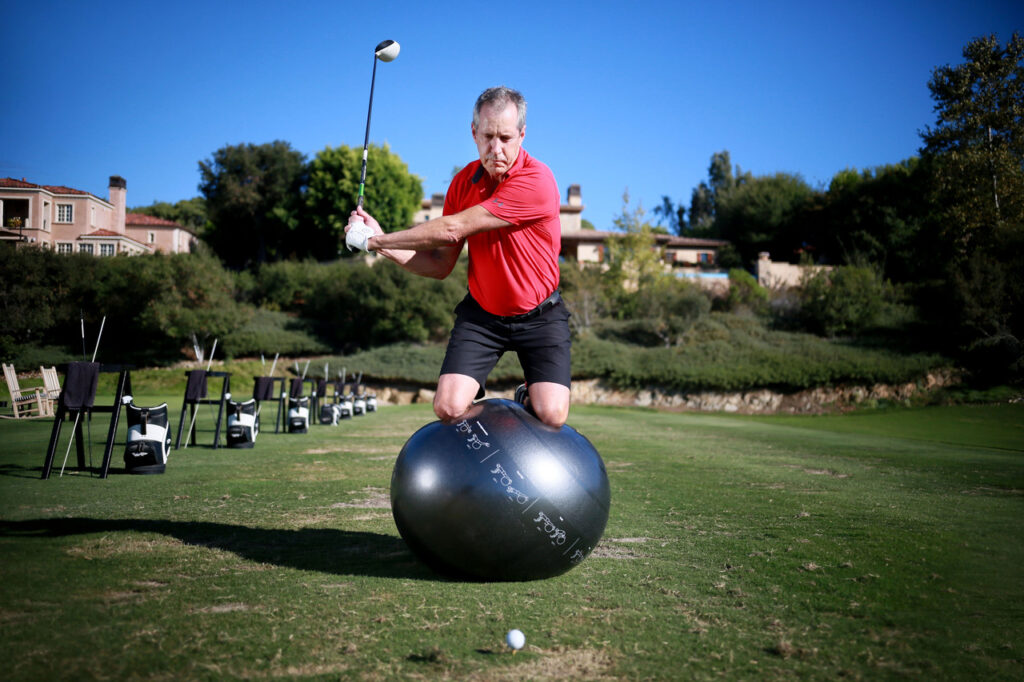
Balance Training for Golfers: Enhancing Coordination and Control
Balance training is a crucial component of a golfer’s fitness routine, playing a significant role in enhancing coordination and control on the course.
We will explore the various types of balance training exercises that can improve golf performance, how golfers can incorporate these exercises into their routine, and the numerous benefits that come with enhancing stability and control through balance training.
Discover how balance training can take your golf game to the next level.
What Is Balance Training?
Balance training is a crucial component for golfers looking to enhance their performance on the course. It focuses on improving coordination, control, strength, and stability, particularly in the core muscles that are essential for a golfer’s swing.
By incorporating balance exercises into their training routine, golfers can significantly increase their ability to maintain proper body alignment and weight distribution throughout their swing. Strong core muscles play a pivotal role in generating power and control in each shot, making them an integral part of a golfer’s overall performance. With enhanced stability and proprioception gained from balance training, golfers can improve their consistency, accuracy, and distance on the course, ultimately leading to a more effective and efficient game.
Why Is Balance Important for Golfers?
Balance is a foundational element for golfers as it plays a vital role in injury prevention, muscle engagement, and maintaining precise body control throughout the golf swing.
Proper balance allows golfers to distribute their weight evenly, ensuring stability and a solid foundation for executing powerful and accurate swings. When a golfer has good balance, they can shift their weight smoothly during the swing, generating efficient power transfer from the ground up. This not only enhances the performance but also reduces the risk of strain or injury on different parts of the body.
By honing balance, golfers can achieve better coordination between their upper and lower body movements, resulting in more consistent and controlled shots on the course.
How Does Balance Training Improve Golf Performance?
By enhancing strength and stability, balance training directly impacts golf swing mechanics, leading to improved performance, fitness, and overall athleticism on the golf course.
With a focus on maintaining a solid foundation and control over body movements, golfers can develop better coordination and proprioception through balance training. This improved body awareness translates to more precise and powerful swings, ultimately resulting in enhanced shot accuracy and distance. By building core strength and improving stability, golfers can prevent injuries and maintain consistency in their performance on the course. Incorporating balance exercises into a golf training regimen can also help golfers generate more power and efficiency in their movements, ultimately leading to a more competitive edge.
What Are the Types of Balance Training for Golfers?
There are various types of balance training designed specifically for golfers, including functional training, dynamic balance exercises, stability techniques, and specific exercises to target core stability.
The functional training aspect focuses on movements that mimic the actions performed during a golf swing, helping improve muscle memory and coordination.
Dynamic balance exercises challenge the golfer to maintain stability while in motion, simulating the dynamic shifts and weight transfers required during a swing.
Stability techniques aim to enhance overall body control, aiding in proper weight distribution and posture throughout the swing.
Core-specific exercises play a crucial role in strengthening the muscles that support the spine and pelvis, aiding in better stability and power generation during the golf swing.
Static Balance Training
Static balance training focuses on foundational balance techniques and stability exercises that are essential for improved golf performance, agility, and maintaining proper posture during swings.
By incorporating static balance training into your golf routine, you can enhance your ability to generate power and control throughout your swing. These exercises help to strengthen the core muscles, improve coordination, and increase overall body awareness.
Practicing static balance techniques regularly can also aid in injury prevention by improving joint stability and proprioception. Maintaining proper posture and stability during swings can lead to more consistent ball-striking and overall performance on the golf course.
Integrating static balance training methods can significantly benefit your golf game in various ways.
Dynamic Balance Training
Dynamic balance training involves engaging in balance workouts that enhance coordination skills, optimize golf practice sessions, improve strength and conditioning, and introduce balance challenges to golfers.
These regimens often incorporate exercises that target specific muscle groups essential for stability and control, such as single-leg squats, plank variations, and lateral lunges. By focusing on these movements, individuals can develop better proprioception and body awareness, which are crucial for maintaining balance on the golf course.
Incorporating unstable surfaces like balance boards or Bosu balls into training routines can further challenge the body’s ability to stabilize and adapt, translating to improved performance in golf swings and overall athletic movements.
Proprioceptive Balance Training
Proprioceptive balance training involves specific drills that refine golf swing control, aid in injury prevention, enhance golf conditioning, and promote optimal muscle engagement during swings.
These drills are essential for golfers looking to improve their overall performance on the course. By incorporating proprioceptive balance training into their routine, golfers can develop a strong sense of body awareness, leading to more precise movements and better ability to adjust to varying surfaces and conditions. This type of training helps to build stability in key muscle groups, reducing the risk of common golf-related injuries.
Through consistent practice of proprioceptive exercises, golfers can fine-tune their skills and elevate their game to new heights.
Unstable Surface Training
Utilizing unstable surface training methods can lead to significant balance improvement, establish effective exercise routines, enhance golf movement patterns, strengthen lower body stability, and improve overall flexibility for golfers.
By incorporating exercises on unstable surfaces, golfers can challenge their core stability and proprioception, which are essential for executing precise golf swings. This type of training helps golfers develop a more solid foundation, leading to improved weight shift during swings and better control over their body movements. The increased demand on stabilizing muscles promotes better coordination and body awareness, crucial elements for executing delicate shots with precision on the golf course. Integrating unstable surface training into their regimen can help golfers boost their performance and reduce the risk of injuries.
How Can Golfers Incorporate Balance Training into Their Routine?
Golfers can seamlessly integrate balance training into their routines by incorporating specific techniques that focus on enhancing balance control, improving golf swing speed, and utilizing specialized balance training equipment.
One effective way for golfers to improve their balance control is by practicing one-legged exercises both on and off the course. Balancing on one leg while swinging a golf club can help strengthen the core muscles essential for stability during a swing. Using wobble boards or stability balls during workouts can further challenge balance and proprioception, leading to increased overall stability and coordination on the golf course.
Balance Exercises on the Course
Performing balance exercises directly on the golf course can include a combination of specific balance training exercises, stability drills, skill development activities, and routines that enhance both balance and strength for golfers.
These exercises play a crucial role in improving a golfer’s overall stability, helping them maintain control and precision throughout their swing. Incorporating dynamic exercises like single-leg stands, heel-to-toe walks, and stability ball drills can significantly enhance core strength and balance. Practicing yoga poses that focus on balance, such as tree pose or warrior III, can also aid in developing stability on the golf course. By consistently engaging in these types of exercises, golfers can enhance their performance by building a strong foundation of balance and stability.”
Balance Exercises in the Gym
Incorporating balance exercises within the gym setting can involve utilizing stability balls, focusing on flexibility enhancement, improving balance and flexibility simultaneously, refining golf swing accuracy, and following a structured balance training program.
Using stability balls in workouts not only challenges one’s balance but also engages core muscles for enhanced stability. Incorporating flexibility exercises alongside balance training can lead to improved joint mobility and reduced risk of injuries. The combination of balance and flexibility exercises can further enhance overall athletic performance and coordination.
Specifically, for golf enthusiasts, refining balance through targeted exercises can significantly improve precision and power in their swings. Adhering to a well-structured balance training program ensures gradual progress and optimal results in terms of strength, stability, and agility.
What Are Some Common Balance Training Exercises for Golfers?
Common balance training exercises for golfers include focusing on core strength development, following structured exercise routines, employing specific balance techniques, refining golf movement control, and engaging in targeted balance drills.
Engaging in exercises that target core muscles can greatly enhance a golfer’s stability and power throughout their swing. By consistently integrating balance training into their routine, golfers can improve their overall performance on the course. Utilizing specialized techniques, such as stability balls or balance boards, can further challenge and strengthen key muscle groups essential for maintaining proper posture and alignment during a swing.
Mastery of controlling golf movements, such as weight shifting and rotational balance, is crucial for precision and consistency in shots. Focused balance drills can help golfers fine-tune their equilibrium, leading to improved coordination and control during their game.
Single Leg Balance
The single leg balance exercise aids in achieving golf swing consistency, enhancing balance and control, fostering skill development, supporting strength training efforts, and incorporating specific balance training techniques.
By focusing on stability and proprioception, this exercise helps golfers refine their weight shift during the swing, leading to improved shot accuracy. It enhances overall body awareness, which is crucial for maintaining posture throughout the golf swing.
Engaging in this exercise regularly can also assist in preventing injuries by strengthening the stabilizing muscles around the ankle, knee, and hip joints. Variations such as adding a medicine ball or performing it on an unstable surface can further challenge coordination and core stability, ultimately enhancing a golfer’s performance on the course.
Bosu Ball Squats
Engaging in Bosu ball squats can enhance golf swing power, improve balance and control, strengthen golf-specific muscles, complement stability training programs, and serve as effective balance training drills for golfers.
By incorporating Bosu ball squats into their training routines, golfers can effectively target key muscle groups essential for a powerful and controlled swing. This exercise helps in developing core strength, which is vital for maintaining proper alignment and posture throughout the swing. The unstable surface of the Bosu ball challenges the golfer’s balance, mimicking the dynamic movements encountered during a golf swing. This not only enhances overall stability but also improves coordination and proprioception, leading to more precise and consistent shots on the course.
Medicine Ball Rotations
Incorporating medicine ball rotations into routines can enhance golf swing efficiency, promote effective body control during swings, support strength and conditioning efforts, improve swing precision, and serve as valuable golf balance exercises.
These dynamic rotational exercises are particularly beneficial for golfers as they help in establishing a strong connection between the upper and lower body movements, leading to a more synchronized and powerful swing. By engaging various muscle groups, the medicine ball rotations contribute to building overall strength and core stability, which are crucial for maintaining balance and generating optimal force through the swing motion. The repetitive nature of these exercises helps in refining coordination, timing, and control, ultimately translating into improved accuracy and consistency in golf shots.”
Balance Board Lunges
Incorporating balance board lunges can enhance golf swing accuracy, improve balance and stability, optimize swing balance, complement stability training programs, and act as beneficial elements of golf balance workouts.
These dynamic exercises help in strengthening the core muscles, promoting better weight distribution during the swing. By engaging in lunges on the balance board, players can also focus on developing proper body alignment and posture, which are crucial for a consistent and powerful golf swing. The instability of the balance board challenges proprioception and neuromuscular control, leading to improved overall balance on the course. With regular practice, golfers can see significant improvements in their swing mechanics and overall performance.
What Are the Benefits of Balance Training for Golfers?
Balance training offers numerous benefits for golfers, including improved stability and control, reduced risk of injury, increased distance and accuracy in shots, and enhanced coordination and timing on the course.
By incorporating balance exercises into their training routine, golfers can help strengthen the muscles responsible for maintaining their posture and stance during swings, leading to a more consistent and powerful shot. Enhanced stability in the lower body can contribute to a smoother weight transfer during the swing, resulting in improved shot accuracy and distance.
Better coordination and timing developed through balance training can help golfers achieve a more fluid and efficient swing motion, ultimately enhancing their overall performance on the golf course.
Improved Stability and Control
Enhanced stability and control resulting from balance training contribute to better body control, improved strength and conditioning, utilization of specific balance techniques, engagement in golf strength training, and overall balance improvement.
The benefits of improved stability and control achieved through balance training extend far beyond physical prowess. By honing one’s balance, individuals can enhance their coordination, reduce the risk of falls or injuries, and even boost their athletic performance.
It fosters a more intuitive understanding of how to distribute weight effectively, which can lead to increased power and agility in various sports and physical activities. Balanced individuals tend to experience heightened proprioception and spatial awareness, enabling them to move with precision and confidence in any environment.
Reduced Risk of Injury
By improving balance, golfers can reduce the risk of injuries, especially those related to golf swing precision, lower body stability, swing balance issues, coordination challenges, and maintaining balance and strength throughout the game.
Enhanced balance contributes significantly to injury prevention in various ways. A stable base allows for better weight distribution during the swing, which can minimize strain on the muscles and joints.
Improved lower body stability leads to a more controlled and powerful swing. Better coordination, stemming from enhanced balance, helps golfers execute complex movements with greater precision.
Consistent maintenance of balance and strength is crucial for preventing overuse injuries and maintaining overall performance on the golf course.
Increased Distance and Accuracy
Balanced training leads to increased shot distance and accuracy by refining golf swing mechanics, boosting swing speed, engaging in golf-specific training methods, recognizing optimal movement patterns, and utilizing specialized balance training equipment.
By incorporating balance training into your golf regimen, you can significantly improve your overall performance on the course. Through focused exercises that target core stability and proprioception, golfers can enhance their ability to generate power and maintain control throughout their swing.
The use of balance training equipment such as stability balls, balance boards, and resistance bands helps develop muscle strength and coordination essential for a fluid and efficient golf swing. These training tools not only aid in physical conditioning but also aid in mental focus and concentration during critical shots.
Enhanced Coordination and Timing
Improved coordination and timing as a result of balance training involve dynamic control over movements, precise management of golf movement patterns, development of coordination skills, accuracy enhancement in the golf swing, and utilization of effective balance training techniques.
Engaging in balance training not only refines one’s physical movements but also fine-tunes the mind-body connection crucial for a successful golf game. By incorporating exercises that challenge stability and proprioception, golfers can refine their muscle memory, ensuring fluid and efficient movement sequences. These training routines also focus on enhancing reaction times, allowing players to adapt swiftly to varying course conditions, ultimately leading to improved shot accuracy and overall performance on the green.
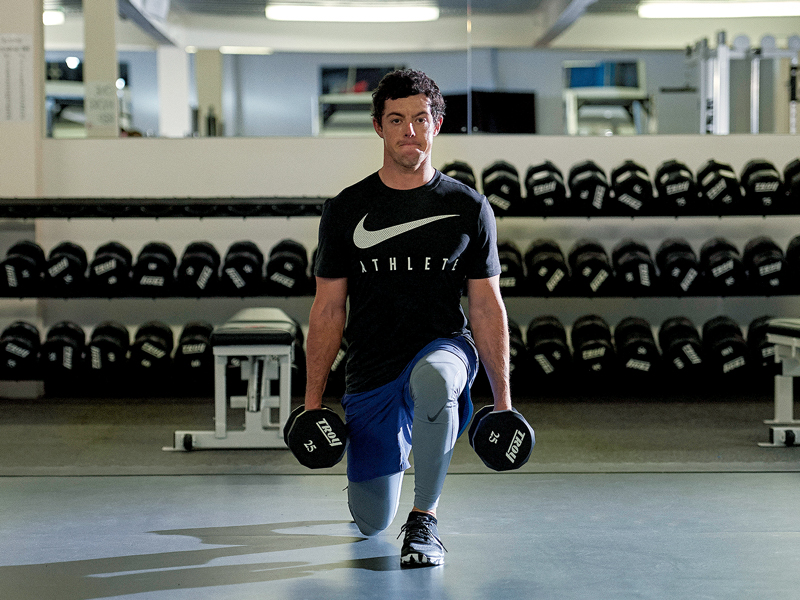
Strength Training for Golf: Maximizing Power without Sacrificing Form
Are you looking to take your golf game to the next level? Strength training could be the missing piece to help you maximize power without sacrificing form.
We will discuss the importance of strength training for golfers, the key muscles used in golf, how strength training can improve your golf swing, the most effective exercises for golfers, and how to incorporate strength training into your routine.
Stay tuned for tips on preventing injuries, maintaining proper form, measuring progress, and more!
What Is Strength Training for Golf?
Strength training for golf involves specific exercises and routines designed to improve muscle strength, power, and endurance to enhance athletic performance on the golf course.
By incorporating strength training into their fitness regimen, golfers can experience a wide range of benefits that directly translate to their performance on the green. Increasing muscle strength helps golfers achieve more distance on their shots and better control over their swing. Building power through targeted exercises can enhance the speed and accuracy of their movements, leading to improved overall performance.
These physical improvements not only contribute to better scores but also help prevent injuries common in golf due to the repetitive nature of the swing. Therefore, strength training plays a crucial role in maximizing a golfer’s potential and maintaining longevity in the sport.
Why Is Strength Training Important for Golfers?
Strength training is crucial for golfers as it enhances power development, muscle strength, and overall athletic performance, while reducing the risk of injuries on the golf course.
By incorporating strength training into their fitness routines, golfers can significantly improve their swing power and distance. Building muscle strength through targeted exercises enhances the golfer’s ability to generate clubhead speed, translating into longer drives and more precise shots.
Strength training plays a vital role in improving overall fitness levels, enhancing endurance and stability, which are essential for maintaining consistency throughout a round of golf. By strengthening the muscles and joints, golfers can decrease the likelihood of injuries, ensuring they stay on top of their game for longer periods with reduced downtime due to physical strains.
What Are the Benefits of Strength Training for Golfers?
Strength training for golfers offers a wide range of benefits, including improved core stability, flexibility, endurance, and overall performance enhancement on the golf course.
By incorporating strength training into their workout routines, golfers can significantly enhance their ability to generate power and maintain balance throughout their swings. A strong core is essential for generating clubhead speed and maintaining proper posture during the golf swing. Improved flexibility from targeted exercises can increase the golfer’s range of motion, allowing for a more fluid and efficient swing. Endurance training helps golfers stay energized and focused throughout a round, leading to more consistent play. Designing a comprehensive strength training program tailored to a golfer’s specific needs can optimize these benefits, thereby improving their overall athletic performance and golf game.
What Are the Key Muscles Used in Golf?
Key muscles used in golf include those involved in the golf swing, rotational power generation, and maintaining mobility throughout the swing sequence.
The muscles primarily engaged in executing a powerful golf swing are the core muscles, such as the obliques, rectus abdominis, and erector spinae. These muscles provide stability and transfer energy from the lower body to the upper body during the swing. The muscles in the shoulders and upper back, like the deltoids, infraspinatus, and latissimus dorsi, play a crucial role in generating clubhead speed and control. Strengthening these muscle groups not only enhances performance but also helps prevent injuries by promoting proper alignment and balance in the golf swing.
How Does Strength Training Help Strengthen These Muscles?
Strength training plays a vital role in strengthening the key muscles used in golf through targeted strength exercises, resistance training, and power development routines.
By incorporating exercises such as squats, deadlifts, and lunges, golfers can effectively target their leg muscles crucial for generating power during swings. Resistance band training can help improve stability and rotational strength necessary for a powerful swing. To enhance upper body strength, exercises like rows and shoulder presses are beneficial. It’s essential for golfers to focus on proper form and technique in these exercises to maximize their benefits and reduce the risk of injury.
Power development strategies, such as medicine ball throws and plyometric exercises, can further enhance a golfer’s explosive strength on the course.
How Can Strength Training Improve Your Golf Swing?
Integrating strength training into your routine can significantly enhance your golf swing mechanics by improving muscle strength, promoting proper technique, and facilitating strength gains for more powerful swings.
By utilizing specific exercises that target the key muscles involved in the golf swing, such as the core, arms, and legs, you can fine-tune your muscle coordination and stability. Strengthening your core muscles, like the obliques and transverse abdominis, can improve trunk rotation and generate more power in your swing.
Exercises that focus on the upper body, such as rows and overhead presses, can enhance shoulder stability and increase clubhead speed. Incorporating lower body exercises like squats and lunges can boost overall strength and balance for a more controlled and precise swing.
What Are the Most Effective Strength Training Exercises for Golfers?
Effective strength training exercises for golfers encompass functional training routines, flexibility exercises, and tailored training intensities to enhance golf-specific muscle strength and mobility.
- Incorporating exercises that focus on improving core stability, such as plank variations, bird dogs, and cable wood chops, can help golfers generate power and control during their swings.
- Rotational power can be enhanced through exercises like medicine ball twists, Russian twists, and golf club rotations.
- Overall strength building exercises like squats, deadlifts, and lunges help increase muscle strength and endurance, translating into improved performance on the golf course.
By combining these elements into a well-rounded strength training program, golfers can see significant enhancements in their game.
How Often and How Long Should You Strength Train for Golf?
The frequency and duration of strength training for golf should be structured within a comprehensive training program, balancing muscle endurance development, training intensity, and recovery periods for optimal results.
When incorporating strength training into a golfer’s regimen, it is recommended to engage in these sessions at least two to three times per week. Each session should ideally last around 45 minutes to an hour, focusing on various muscle groups and functional movements specific to the demands of golf. It’s important to vary the intensity of workouts, incorporating both heavier lifts for strength gains and lighter resistance exercises for muscular endurance. Allowing for adequate rest between sessions is essential to prevent overtraining and promote muscle recovery for better performance on the course.
How Can You Incorporate Strength Training into Your Golf Routine?
Incorporating strength training into your golf routine involves integrating targeted exercises, seeking guidance from a strength coach, and aligning training techniques with golf-specific performance enhancement goals.
- To seamlessly integrate strength training into your golf regimen, consider incorporating bodyweight exercises like squats, lunges, and planks to improve core stability and power generation in your swing.
- Pairing these exercises with your golf practice session can help reinforce muscle memory and improve your overall performance on the course.
- Working closely with a strength coach is crucial to tailor workouts to address your specific areas of improvement and avoid injury.
- Setting clear performance enhancement goals through strength training will keep you focused and motivated to achieve your desired results.
What Are the Best Ways to Warm Up and Cool Down for Strength Training?
Effective warm-up and cool-down routines for strength training in golf should focus on enhancing mobility, improving flexibility, and reducing the risk of injuries before and after workout sessions.
Mobility exercises play a crucial role in preparing the body for the dynamic movements involved in golf swings. Including movements like leg swings, arm circles, and torso rotations can help increase range of motion in key joints. Flexibility drills are also essential for golfers to maintain proper posture and alignment throughout their swing. Incorporating stretches for the hips, hamstrings, and shoulders can improve overall flexibility. Implementing injury prevention techniques such as foam rolling specific muscle groups and performing stability exercises can help ensure long-term joint health and performance on the golf course.
How Can You Prevent Injury While Strength Training for Golf?
Preventing injuries during strength training for golf requires maintaining proper form, prioritizing core stability, and gradually increasing training intensity to avoid overexertion and strain on muscles.
One crucial aspect of injury prevention in golfers’ strength training is to focus on core stability, as a strong core enhances overall body control and helps transfer power efficiently from the lower body to the club. By strengthening core muscles through targeted exercises like planks, twists, and bridges, golfers can improve their balance, reduce the risk of back injuries, and enhance their swing mechanics. Integrating progressive training methods such as periodization can help golfers build strength gradually while allowing for adequate rest and recovery, further reducing the likelihood of overuse injuries.
What Are the Most Common Injuries in Golf and How Can Strength Training Help?
Common injuries in golf include strains, sprains, and overuse injuries that can be mitigated through strength training focusing on muscular endurance, mobility enhancement, and injury prevention strategies.
Strength training interventions play a crucial role in helping golfers prevent these injuries by building up the muscles surrounding vulnerable areas. Exercises such as lunges, squats, and planks can improve core strength and stability, reducing the risk of strains and sprains.
Incorporating stretches for the shoulders, hips, and hamstrings can enhance mobility, aiding in maintaining proper form during swings and reducing the likelihood of overuse injuries. Implementing injury prevention techniques like proper warm-ups and cool-downs further fortifies the body against common golf-related injuries.
What Are Some Tips for Maintaining Proper Form During Strength Training?
Maintaining proper form during strength training for golf is essential for maximizing workout effectiveness, preventing injuries, and optimizing strength and conditioning gains for improved performance.
One key tip is to focus on core engagement throughout exercises to stabilize the body and enhance power generation, which is crucial for golf swings. Ensuring proper breathing techniques can help maintain energy levels and reduce the risk of muscle strain. It’s also important to pay attention to body alignment and posture to prevent imbalances that can impact performance on the golf course.
By incorporating these tips into your strength training routine, you can make significant progress in developing the strength and stability needed for a successful golf game.
How Can You Measure Your Progress in Strength Training for Golf?
Tracking progress in strength training for golf can be achieved through monitoring strength gains, power development improvements, and overall performance enhancements on the golf course.
One effective method for measuring progress in strength training specific to golf is to maintain detailed workout logs to track the weights lifted, number of repetitions completed, and any adjustments made to the exercise routine. Using fitness assessment tools such as strength meters, power meters, and performance trackers can provide quantitative data to evaluate advancements in strength and power development. Setting specific goals related to strength gains and power output can help in establishing benchmarks for progress evaluation and motivate consistent training efforts.

Core Strength for Golf: Exercises to Improve Your Swing Stability
If you’re looking to improve your golf game, one key aspect to focus on is your core strength.
But what exactly is core strength, and why is it so important for golfers?
In this article, we’ll explore the key muscles used in golf and how they impact your swing.
We’ll also provide you with a variety of exercises to enhance your core strength, including planks, Russian twists, and medicine ball rotational throws.
Plus, we’ll share tips on how to maintain good core strength for golf and offer guidance on how often to do these exercises.
So, if you’re ready to take your swing stability to the next level, keep reading!
What Is Core Strength?
Core strength refers to the ability of the muscles in the torso to support the spine and pelvis, providing a solid foundation for movement. In the context of golf, core strength plays a crucial role in stabilizing the body during the swing, transferring power from the lower body to the club. It is essential for maintaining balance, generating power, and ensuring proper body mechanics throughout the golf swing.
A strong core allows golfers to rotate efficiently and generate more clubhead speed, resulting in longer drives and more consistent ball-striking. By enhancing core strength, golfers can also reduce the risk of injuries, especially in the lower back and hips, which are common areas of strain in the golf swing.
Improving core stability can lead to improved posture and alignment, aiding in proper weight shift and alignment through impact. Incorporating core strengthening exercises into a golfer’s training routine can significantly enhance their performance on the course.
Why Is Core Strength Important for Golf?
Core strength is vital for golfers as it enhances swing stability, improves power generation, and sustains balance throughout the swing. A strong core enables golfers to maintain posture, transfer energy efficiently, and minimize the risk of injury. By engaging core muscles, golfers can achieve optimal performance, enhance swing mechanics, and increase clubhead speed, leading to more consistent and powerful shots.
A stable core plays a crucial role in preventing injuries common among golfers, such as lower back pain and shoulder strain. Building core strength not only aids in better weight transfer during the swing but also contributes to overall golf fitness.
Specific exercises targeting the core, such as planks, rotational movements, and med ball throws, are essential for developing the power and stability needed for a strong golf swing. Incorporating these exercises into a golfer’s training routine can significantly improve their performance on the course.
What Are the Key Muscles Used in Golf?
Several key muscles come into play during a golf swing, including the core muscles, which provide stability and power. Mobility and flexibility in muscles such as the shoulders, hips, and spine are crucial for a smooth and efficient swing. Balance muscles in the legs and feet help maintain a solid foundation throughout the swing, allowing for proper weight transfer and control.
Engaging in core activation exercises is essential to ensure that these muscles are adequately primed for the dynamic movements required in a golf swing. Incorporating mobility training for the shoulder and hip joints can enhance the range of motion, enabling a golfer to achieve the desired club path and swing plane. A balance of strength and flexibility in these key muscle groups promotes coordination and consistency in the swing, translating into improved accuracy and power in every shot.
How Do These Muscles Affect Your Swing?
The engagement of core muscles in the golf swing is essential for stabilization, generating power, and controlling the body’s movement. Proper mobility and flexibility in key muscles allow for a full range of motion, enabling a more fluid and efficient swing. These muscles work together to maintain balance, transfer energy, and execute the mechanics of the swing with precision and control.
By incorporating specific stabilization exercises and mobility drills into your training regimen, you can strengthen these core muscles and improve your swing stability. Enhanced muscle coordination not only contributes to a more consistent and effective swing but also helps in transmitting power efficiently from the ground up through each phase of the swing.
Understanding how mobility and flexibility influence swing mechanics can fine-tune your movements, leading to better ball striking and overall performance on the golf course.
Exercises to Improve Core Strength for Golf
Incorporating specific exercises to enhance core strength is crucial for improving golf performance. Golf-specific core exercises such as planks, Russian twists, and side planks target key muscles involved in the swing. Stability exercises like medicine ball rotational throws and mobility drills such as bird dogs and cable wood chops help develop core stability, balance, and mobility essential for a strong and efficient golf swing.
These exercises not only increase the power and efficiency of the golf swing but also help prevent injuries by strengthening the muscles that support the spine and pelvis.
Planks, for instance, engage the entire core, including the rectus abdominis and obliques, promoting stability and alignment during the swing.
Russian twists challenge rotational strength, mimicking the movements required in a golf swing.
Side planks are excellent for building lateral stability, crucial for maintaining posture throughout the swing.
It’s important to incorporate these exercises regularly into your workout routine to see significant improvements in your golf performance.
Plank
The plank exercise is an effective way to engage the core muscles, improve strength, and enhance stability. By maintaining a proper plank position, with the body in a straight line from head to heels, golfers can develop core activation, strengthen the abdominal muscles, and improve overall body control.
Ensuring proper alignment in a plank involves keeping the shoulders stacked over the wrists and maintaining a neutral spine. By actively engaging the core and squeezing the glutes, individuals can maximize the benefits of this exercise. Planks are valuable for enhancing core strength, promoting better posture, and reducing the risk of lower back pain. Consistent practice of planks can also aid in improving balance, enhancing muscle endurance, and boosting overall athletic performance.
Russian Twist
The Russian twist exercise targets the obliques and core muscles, promoting rotational strength and flexibility. By twisting the torso while holding a weight or medicine ball, golfers can improve muscle activation, enhance core stability, and develop the rotational power necessary for an efficient golf swing.
This exercise engages not only the superficial muscles but also the deep stabilizing muscles, making it a comprehensive core workout. The rotational movement challenges the muscles in a unique way, helping to prevent injuries and improve overall performance in various activities. Incorporating resistance such as a dumbbell or kettlebell intensifies the workout, adding an extra layer of challenge to enhance strength and endurance. Including flexibility drills alongside the Russian twist can further improve range of motion and reduce the risk of muscle imbalances.
Side Plank
The side plank exercise is effective for targeting the obliques and improving core strength and stability. By holding a side plank position, golfers can enhance lateral stability, strengthen the core muscles, and improve overall body control for better performance on the course.
Engaging in side planks regularly also aids in preventing injuries by building a strong foundation that supports movements in various directions. The lateral muscle engagement during side planks helps in improving posture and spinal alignment, which are crucial for a golf swing’s efficiency. Incorporating flexibility training alongside side planks can increase range of motion and help golfers achieve a smoother, more powerful swing. By combining these exercises with sports-specific drills tailored for golf, athletes can develop a well-rounded fitness regimen that enhances their performance both on and off the course.
Medicine Ball Rotational Throws
Medicine ball rotational throws are dynamic exercises that engage the core muscles and improve rotational power. By explosively rotating and throwing a medicine ball, golfers can enhance their golf swing mechanics, develop strength and mobility, and create a more powerful and efficient swing.
These exercises specifically target the muscles involved in the golf swing, such as the obliques, abdominals, and lower back muscles, leading to increased stability and power generation during swings. The rotational aspect of the throws mimics the movement patterns in a golf swing, helping golfers improve their coordination and sequencing. The incorporation of medicine ball rotational throws into a golf fitness program can also enhance overall body awareness and proprioception, crucial for optimal performance on the course.
Dead Bug
The dead bug exercise is a core stability drill that enhances muscle coordination and balance. By performing controlled movements that mimic opposite arm and leg extensions, golfers can improve core stability, refine swing techniques, and promote overall golf health and fitness.
This exercise is particularly beneficial for golfers looking to strengthen their core muscles, which are crucial for generating power and maintaining proper posture throughout their swing. The controlled movements engage the deep abdominal muscles and lower back, aiding in injury prevention and improving overall performance on the golf course.
By enhancing muscle coordination and balance, golfers can achieve smoother and more controlled movements, leading to greater accuracy and distance in their shots. Incorporating the dead bug exercise into a regular golf workout routine can significantly enhance both physical fitness and golfing ability.
Bird Dog
The bird dog exercise is a full-body movement that enhances core stability and lower body strength. By extending opposite arm and leg while maintaining a neutral spine, golfers can improve flexibility, increase lower body strength, and enhance range of motion for a more powerful golf swing.
This exercise helps golfers engage their core muscles, including the abdominals and obliques, which are essential for generating rotational power during a golf swing. The coordination required in the bird dog exercise aids in balance and stability, crucial elements for maintaining a consistent and controlled swing. The controlled movement of extending the arm and leg challenges the body’s proprioception, leading to improved body awareness and control, which can translate into more precise and powerful swings on the golf course.
Cable Woodchop
The cable woodchop exercise targets the core muscles and promotes rotational strength and control. By using a cable machine to simulate a woodchopping motion, golfers can enhance core strength progression, improve core activation, refine golf swing control, and optimize golf practice sessions.
This exercise specifically engages the obliques, rectus abdominis, transverse abdominis, and back muscles, creating a strong foundation for rotational power in the golf swing. The dynamic twisting movement mimics the rotational forces involved in a golf swing, translating to better transfer of power from the lower body to the club. Incorporating cable woodchops into a golf training routine can lead to increased distance, accuracy, and consistency in shots. The emphasis on core stabilization during the exercise helps in preventing injuries and promoting overall balance and stability in the golfer’s movements.
How Often Should You Do These Exercises?
To maximize the benefits of core strength exercises for golf, it is recommended to incorporate them into a regular exercise routine. Consistency is key for developing muscular endurance, improving core stability, and enhancing flexibility through targeted drills. Establishing structured training routines that include a variety of exercises will help golfers maintain overall fitness and performance on the course.
By integrating core strength exercises into your workout regimen on a consistent basis, you can gradually increase the intensity and duration of these activities to further challenge your muscles.
Emphasizing a mix of exercises focusing on different aspects of your core, such as rotational movements, planks, and stability exercises, can effectively enhance your golf performance.
Varying your training routines with exercises like Russian twists, medicine ball throws, and resistance band workouts can prevent plateaus and provide a well-rounded approach to enhancing your physical capabilities for golf.
Tips for Maintaining Good Core Strength for Golf
Maintaining good core strength for golf involves consistent core activation, progressive strength building, and attention to proper swing mechanics. Golfers can benefit from working with knowledgeable golf coaches who can provide guidance on core exercises, monitor core health, and offer personalized advice for improving overall golf performance and health.
Engaging in a variety of core activation techniques, such as plank variations, rotational exercises, and stability drills, can help golfers improve their balance and power transfer during swings.
Incorporating strength-building exercises like squats, deadlifts, and medicine ball throws can further enhance core stability and endurance on the course.
By focusing on proper swing mechanics, golfers can optimize their movements, reduce the risk of injury, and achieve more consistent ball striking.
Seeking regular feedback from golf coaches can lead to tailored core training programs that address individual needs and goals, ensuring sustained improvement in both physical fitness and golf performance.
Engage Your Core During Your Golf Swing
One key tip for golfers is to actively engage their core muscles during the golf swing to enhance performance and prevent injuries. A golf-specific training program that focuses on core activation exercises can help improve fitness levels, reduce the risk of injury, and optimize swing mechanics for better overall performance on the course.
Strengthening the core not only stabilizes the body during the swing but also generates power and control. By incorporating exercises that target the abdominal muscles, obliques, and lower back, golfers can achieve a more solid foundation and smoother swing motion. These targeted movements assist in developing rotational power and maintaining proper posture throughout the swing.
Considering individuals’ fitness levels, the training program can be customized to gradually increase intensity and complexity, ensuring each golfer progresses safely. Ultimately, a strong core leads to greater consistency in ball-striking, increased distance, and reduced strain on other areas of the body.
Incorporate Core Exercises into Your Warm-up Routine
Integrating core exercises into your warm-up routine can prepare your body for optimal golf performance. By including exercises that enhance core strength and mobility, golfers can improve functional movement patterns, increase stability, and support overall strength and mobility during the golf swing.
This focus on core stability is vital for maintaining proper posture and alignment through the golf swing, reducing the risk of injuries and enhancing power generation. Core exercises help engage the muscles in the torso, lower back, and pelvis, creating a solid foundation for your golf swing.
Strengthening the core also translates into improved balance and control, allowing golfers to move more efficiently and effectively on the course. Incorporating dynamic movements like planks, twists, and bridges can target multiple muscle groups simultaneously, leading to greater coordination and fluidity in your swing.
Maintain a Balanced Workout Routine
Maintaining a balanced workout routine that includes strength and conditioning, physical therapy, and sports-specific training can benefit golfers’ athletic performance. By integrating exercises that focus on core stability, power development, and injury prevention, golfers can optimize their physical conditioning, enhance their performance, and reduce the risk of common golf-related injuries.
Incorporating strength and conditioning exercises helps golfers build muscle strength and endurance, essential for generating powerful swings on the course. Physical therapy plays a crucial role in preventing and rehabilitating injuries, ensuring that golfers can maintain peak performance levels. Sports-specific training tailored to the demands of golf enhances skill development and technique refinement. By incorporating these elements into their workout routine, golfers can achieve a well-rounded approach to physical preparation that directly translates to improved performance during their game.
Listen to Your Body and Rest When Needed
Listening to your body’s signals and providing adequate rest when needed is essential for maintaining functional strength and optimal golf fitness. Incorporating principles of sports science into your exercise routine can help prevent overtraining, promote recovery, and sustain long-term performance gains in golf workouts.
By understanding the biomechanics of golf swings and the specific muscle groups involved, you can tailor your workouts to target these areas effectively.
Focusing on core strength, flexibility, and power development through exercises like rotational movements, plyometrics, and stability drills can enhance your performance on the course.
Implementing periodization techniques to vary intensity and volume in your training can prevent plateaus and reduce the risk of injury.
Prioritizing quality sleep, proper nutrition, and active recovery strategies will further support your body’s ability to adapt and improve over time.

